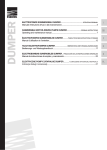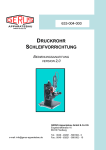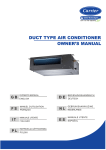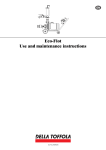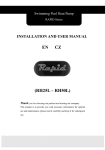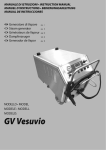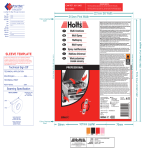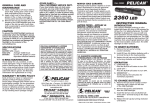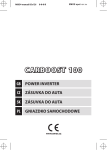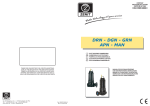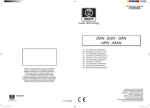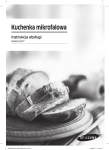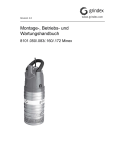Download DUMPER - Ebara
Transcript
DUMPER ELETTROPOMPE SOMMERGIBILI DUMPER............................................................ ISTRUZIONI ORIGINALI Manuale d’istruzione all’uso e alla manutenzione............................................................................................... 2 I SUBMERSIBLE MOTOR-DRIVEN PUMPS DUMPER...................................... ORIGINAL INSTRUCTIONS Operating and maintenance manual.......................................................................................................................... 7 GB ÉLECTROPOMPES SUBMERSIBLES DUMPER..............TRADUCTION DES INSTRUCTIONS D’ORIGINE Manuel d’utilisation et d’entretien..............................................................................................................................12 F TAUCH-ELEKTROPUMPEN DUMPER..................................ÜBERSETZUNG DER ORIGINALANWEISUNGEN Bedienungs- und Wartungshandbuch....................................................................................................................17 D ELECTROBOMBAS SUMERGIBLES DUMPER.... TRADUCCIÓN DE LAS INSTRUCCIONES ORIGINALES Manual de instrucciones de empleo y manutención.......................................................................................22 E ELEKTRYCZNE POMPY ZATAPIALNE DUMPER................ TŁUMACZENIE ORYGINALNEJ INSTRUKCJI Instrukcja obsługi i konserwacji....................................................................................................................................27 PL Stampato su carta reciclata - Nessun albero è stata abbattuto - Marchio “Angelo Blu” ⁄ Printed on resycled paper - no trees have been cutted down - mark “Blue Angel” Istruzioni_Dumper - 6 lingue.indd 1 19/10/11 11.16 MANUALE D’ISTRUZIONE ALL’USO E ALLA MANUTENZIONE DA CONSERVARE A CURA DELL’UTILIZZATORE FINALE 3.2.ELETTROPOMPA Vedi dati di targa (Par. 12.1) 1.INTRODUZIONE Grazie per aver scelto le elettropompe sommergibili NOWAX. I nostri prodotti vengono realizzati con particolare attenzione, al fine di garantire un utilizzo in completa sicurezza. Un uso improprio della elettropompa, tuttavia, può causare incidenti, è necessario perciò attenersi a quanto indicato nel presente manuale d’istruzioni. I Per ottenere l’ottimale rendimento ed il corretto funzionamento dell’elettropompa attenersi alle disposizioni contenute nel presente manuale istruzioni. Per eventuali altre informazioni, interpellate il rivenditore autorizzato più vicino. Il presente manuale d’istruzioni dovrà essere conservato in luogo facilmente accessibile, in modo da consentire una veloce consultazione. È VIETATA A QUALSIASI TITOLO LA RIPRODUZIONE, ANCHE PARZIALE, DELLE ILLUSTRAZIONI E/O DEL TESTO. Nella stesura del libretto istruzioni è stata utilizzata la seguente simbologia: Rischio di arrecare danno ATTENZIONE! alla pompa o all’impianto Rischio di arrecare danno alle persone o alle cose Ricevuta l’elettropompa, verificare che l’imballo non abbia subito rotture o ammaccature rilevanti, altrimenti farlo presente immediatamente a chi ha effettuato la consegna. Quindi, dopo aver estratto l’elettropompa, verificare che non abbia subito danni durante il trasporto; se ciò è accaduto, informare entro 8 giorni dalla consegna il rivenditore. Controllare quindi sulla targhetta dell’elettropompa che le caratteristiche riportate siano quelle da Voi richieste. Le seguenti parti, in quanto normalmente soggette ad usura, godono di una garanzia limitata: - cuscinetti; - tenuta meccanica; - anelli di tenuta; - girante; - diffusore; - piatto di usura. 5. AVVERTENZE DI SICUREZZA Prima di mettere in funzione l’elettropompa, è indispensabile che l’utilizzatore sappia eseguire tutte le operazioni descritte nel presente manuale e le applichi ogni volta durante l’uso o la manutenzione dell’elettropompa. Rischio di natura elettrica 2.INDICE 1.INTRODUZIONE 2.INDICE 3. DATI DI IDENTIFICAZIONE 4. GARANZIA E ASSISTENZA TECNICA 5. AVVERTENZE DI SICUREZZA 6. DESCRIZIONE ED USI ELETTROPOMPA 7. DATI TECNICI 8. TRASPORTO, INSTALLAZIONE E DISINSTALLAZIONE 9. COLLEGAMENTO ELETTRICO 10. AVVIAMENTO E USO 11. MANUTENZIONE 12. TARGA DATI 13. RICERCA GUASTI 14. DEMOLIZIONE 15. SCHEMI 16. DICHIARAZIONE DI CONFORMITÀ 4. GARANZIA E ASSISTENZA TECNICA L’INOSSERVANZA DELLE INDICAZIONI FORNITE IN QUESTO MANUALE ISTRUZIONI E/O L’EVENTUALE INTERVENTO SULLA ELETTROPOMPA NON EFFETTUATO DAI NOSTRI CENTRI ASSISTENZA, INVALIDERANNO LA GARANZIA E SOLLEVERANNO IL COSTRUTTORE DA QUALSIASI RESPONSABILITÀ IN CASO DI INCIDENTI A PERSONE O DANNI ALLE COSE E/O ALLA ELETTROPOMPA STESSA. 5.1.MISURE DI PREVENZIONE A CURA DELL’UTILIZZATORE 2 2 2 2 2 3 3 4 4 4 5 5 6 6 32 37 3. DATI DI IDENTIFICAZIONE 3.1.COSTRUTTORE EBARA PUMPS EUROPE S.p.A. Direzione di stabilimento: Via Pacinotti, 32 - 36040 BRENDOLA (VI) ITALIA Telefono: +39 0444 706811 - Telefax: +39 0444 405811 Sede legale: Via Campo Sportivo, 30 - 38023 CLES (TN) ITALIA Telefono: +39 0463 660411 - Telefax: +39 0444 405930 L’utilizzatore deve osservare tassativamente le norme antinfortunistiche in vigore nel proprio Paese; deve inoltre tenere conto delle caratteristiche della elettropompa (vedi Cap. 7 “DATI TECNICI”). Durante la movimentazione, la manutenzione, o la riparazione dell’elettropompa interrompere l’alimentazione elettrica, impedendone così l’avviamento accidentale che potrebbe causare danni alle persone e/o alle cose. Ogni operazione di manutenzione, installazione o movimentazione effettuata sull’elettropompa con l’impianto elettrico sotto tensione, può provocare gravi incidenti, anche mortali, alle persone. Nell’avviare l’elettropompa, evitare di essere a piedi nudi o, peggio, nell’acqua e di avere le mani bagnate. L’utilizzatore non deve eseguire di propria iniziativa operazioni o interventi che non siano ammessi in questo manuale. 2 Istruzioni_Dumper - 6 lingue.indd 2 19/10/11 11.16 Ogni conduttore o parte in tensione è elettricamente isolato rispetto alla massa; vi è comunque una sicurezza supplementare costituita dal collegamento delle parti conduttrici accessibili ad un conduttore di terra per far si che le parti accessibili non possano diventare pericolose in caso di guasto all’isolamento principale. 6. DESCRIZIONE ED USI ELETTROPOMPA 6.1.DESCRIZIONE Denominazione ELETTROPOMPE SOMMERGIBILI Modello DUMPER (vedi dati di targa) 6.2.USO PREVISTO Le elettropompe sono idonee a movimentare acqua contenente solidi in sospensione come descritto nel Par. 7.1. 6.3.USO NON PREVISTO Le pompe non sono idonee a: - trattare liquidi diversi dall’acqua; - trattare acqua avente PH non compreso nell’intervallo indicato in 7.1; - trattare acqua di mare (ad esclusione delle versioni in AISI 316); - trattare liquidi infiammabili ed in genere pericolosi; - entrare in contatto con prodotti alimentari; - essere utilizzate in strutture destinate ad organismi viventi (piscine, acquari, allevamenti di pesci, ecc); - essere utilizzate diversamente da quanto indicato nel Cap. 6.2 “Uso previsto”. 7. DATI TECNICI Il costruttore si riserva di modificare i dati tecnici per apportare migliorie e aggiornamenti senza darne preavviso. 7.1.DATI TECNICI POMPE SERIE DUMPER Massima densità relativa liquido trattato 1.1 PH liquido trattato 5÷8 Temperatura liquido trattato [°C] 0 ÷ 40 minima [m] 0.127 profondità di immersione massima [m] 20 DUMPER 1(0, 1) DUMPER 2(0, 1) DUMPER 3(0, 1) 53.7-S [mm] Ø6 DUMPER 3(0, 1) 55.5-S DUMPER 30 57.5-S DUMPER 51 58-S DUMPER 3(0, 1) 53.7-M [mm] 25x6 DUMPER 3(0, 1) 53.7-L DUMPER 3(0, 1) 55.5-M [mm] 30x9.5 DUMPER 3(0, 1) 57.5-M DUMPER 4(0, 1) 512-S DUMPER 6(0, 1) 519-S [mm] Ø10 DUMPER 6(0, 1) 526-S DUMPER 4(0, 1) 512-M [mm] 25.5x5 DUMPER 6(0, 1) 519-M DUMPER 6(0, 1) 526-M [mm] 25.5x10 DUMPER 6(0, 1) 537-M DUMPER 70 [mm] Ø 13 I Massima dimensione corpi solidi in sospensione 5.2.PROTEZIONE E CAUTELE SIGNIFICATIVE 7.2.DATI TECNICI MOTORI Le pompe con motore monofase, ad esclusione della DUMPER 10 51-S M, devono essere pilotate da un quadro elettrico dotato di condensatori di avvio, di marcia e relè di avvio. Condensatori e relè per motori monofase [μF] 215-259 Condensatore di avvio Sc [V] 220-250 [μF] 35 Condensatore di marcia Rc [V] 370-440 Tensione massima [V] 332 Relè di avvio Tensione di sgancio [V] 244-270 Tensione di innesco [V] 40-90 Dati elettrici Vedi dati di targa DUMPER 10 51-S M Protezione da DUMPER sovrariscaldamento 51 58-S Le altre Massimo numero di avviamenti orari Tolleranza sulla tensione Tolleranza sulla frequenza Motoprotettore a riarmo automatico Sonda termica con contattore a riarmo automatico Sonda termica (da connettere al quadro) 15 ± 6% ± 3% I motori delle pompe DUMPER possono essere pilotati con inverter/VFD. 3 Istruzioni_Dumper - 6 lingue.indd 3 19/10/11 11.16 8. TRASPORTO, INSTALLAZIONE E DISINSTALLAZIONE 8.1.TRASPORTO Le elettropompe in funzione del peso e/o delle dimensioni sono imballate in una scatola di cartone o in una gabbia in legno; comunque sia il trasporto non richiede particolari accorgimenti. In ogni caso verificare il peso totale impresso sull’imballo. I Non immergere mai l’estremità del cavo o eventuali giunzioni tra cavi in acqua. Sostenere il cavo fissandolo alla tubazione di mandata. 8.2.MOVIMENTAZIONE Evitare che il cavo sia direttamente esposto alla luce del sole o che venga attorcigliato per prevenirne il surriscaldamento. Prima di movimentare le pompe assicurarsi che siano scollegate dalla fonte di alimentazione. Movimentare le pompe utilizzando l’apposita maniglia o i golfari; non sollevarle in NESSUN CASO dai cavi elettrici. Con riferimento alla tabella relativa al colore dei cavi (Fig. 15.2.1) eseguire i collegamenti elettrici secondo gli schemi indicati nella tabella sotto: Schema elettrico In funzione del loro peso, le pompe potranno essere spostate a mano o con l’aiuto di specifiche attrezzature. In ogni caso si dovrà utilizzare l’apposita maniglia. Pompa DUMPER 10 51-S M Fig. 15.2.4 8.3.INSTALLAZIONE Con l’ausilio di un megaohmmetro misurare la resistenza di isolamento tra il filo di messa a terra e le fasi. Se la resistenza di isolamento nelle rispettive sezioni è inferiore a 500MΩ far controllare la pompa. Durante la misurazione, tenere la sezione di collegamento all’alimentazione elettrica lontana da terra. DUMPER 51 58-S Fig. 15.2.5 Pompe monofasi Fig. 15.2.2 Pompe trifasi fino a 7.5 kW (DOL) Fig. 15.2.6 Pompe trifasi a partire da 12 kW (Y/Δ) Fig. 15.2.3 Nell’installazione della pompa seguire le seguenti indicazioni: - la pompa può funzionare in qualsiasi posizione; - le tubazioni vanno supportate ed allineate in modo che non creino sollecitazioni sulla pompa; - evitare di impiegare nell’impianto troppe curve (colli d’oca) e valvole; - le pompe non hanno un sistema di controllo contro il funzionamento a secco; tenerne conto in caso di funzionamento non presieduto. 9. COLLEGAMENTO ELETTRICO Fare riferimento al paragrafo 7.2 per i dati elettrici - - IL COLLEGAMENTO ELETTRICO DEVE ESSERE EFFETTUATO DA UN TECNICO QUALIFICATO. È CONSIGLIABILE INSTALLARE NELL’IMPIANTO ELETTRICO UN INTERRUTTORE DIFFERENZIALE AD ALTA SENSIBILITÀ. L’alimentazione dell’elettropompa dovrà avvenire tramite un quadro elettrico provvisto di interruttore, fusibili ed interruttore termico tarato sulla corrente assorbita dall’elettropompa. La rete deve avere un efficiente impianto di messa a terra secondo le norme elettriche vigenti nel Paese: questa responsabilità è a carico dell’installatore. Per prevenire la possibilità folgorazione in caso di guasto, installare un interruttore differenziale da usare esclusivamente per la pompa. Non collegare il cavo giallo verde all’alimentazione elettrica: esso va collegato esclusivamente alla messa a terra. Immergere la pompe ed avviarla. Nel caso di pompe trifasi controllare il senso di rotazione se la corrente supera il dato di targa, la portata è ridotta e dalla pompe proviene un rumore insolito. Se necessario invertire due fasi nel quadro di comando. Può accadere che con cavi di alimentazione molto lunghi l’interruttore differenziale intervenga in modo intempestivo, soprattutto nella fase di avvio della pompa. Per ovviare al problema installare un interruttore differenziale con minor sensibilità. Nel caso la pompa sia dotata di sonda termica inserita all’interno del motore collegare i conduttori provenienti dalla stessa al quadro di comando per realizzare la protezione contro il surriscaldamento. 10.AVVIAMENTO E USO ATTENZIONE! Non far funzionare la pompa in condizioni diverse da quelle indicate nel cap. 7. ATTENZIONE! Evitare il funzionamento della pompa senza acqua per più di 30 minuti. Non utilizzare la pompa se persone o animali sono a contatto con l'acqua. Eseguiti i collegamenti, accendere e spegnere un paio di volte la pompa con la valvola in mandata (se presente) leggermente aperta per verificare l’impianto. Accendere la pompa ed aprire gradualmente la valvola in mandata (se presente) fino al raggiungimento della portata voluta. 4 Istruzioni_Dumper - 6 lingue.indd 4 19/10/11 11.16 11.MANUTENZIONE 12. TARGA DATI Ogni intervento di manutenzione che preveda lo smontaggio ed il rimontaggio della pompa deve essere eseguito da un tecnico specializzato Ogni intervento di manutenzione deve essere effettuato con la pompa scollegata dalla alimentazione In condizioni d’uso normali la pompa va revisionata ogni 12 mesi (ogni 2500 ore di funzionamento circa); se le condizioni d’uso sono gravose ridurre l’intervallo di tempo a 6/8 mesi (2000 ore circa). Per mantenere inalterate le prestazioni della pompa nel tempo ripristinare il corretto rasamento della girante (vedi par. 11.2) ad ogni revisione. Sottoporre la pompa a manutenzione regolare secondo la seguente tabella. Particolare 1Modello 2 Codice articolo 3 Portata minima e massima in l/min 4 Prevalenza alla minima e massima portata in m 5 Prevalenza massima in m 6 Tipo di motore (mono o trifase) 7 Potenza in kW 8 Tensione nominale in V 9 Corrente nominale in A 10 Frequenza nominale in Hz 11 Prevalenza minima in m 12 Numero di giri in min-1 13 Capacità del condensatore (solo per monofase) 14 Tensione del condensatore (solo per monofase) 15 Massima temperatura del liquido 16 Grado di protezione della pompa 17 Classe di isolamento e tipo di servizio 18 Peso in kg 19 Numero di serie 20 Massima profondità di funzionamento I Periodo/Evento Olio lubrificante Controllarne stato e livello ogni 6 mesi. Se presenta tracce d’acqua sostituirlo (ad ogni intervento sostituire la rondella di tenuta). Tenuta meccanica Controllarne lo stato in caso di tracce d’acqua nell’olio. Anelli O-ring, Guarnizioni Sostituirli ad ogni smontaggio. Cuscinetti Sostituirli ogni 10000 ore. 11.1. Rabbocco/sostituzione lubrificante Rabboccare o sostituire il lubrificante tramite il foro posto sul fianco del motore ponendo la pompa in orizzontale (vedi Fig. 15.3.1). Assicurarsi che nella camera d’olio vi sia la quantità di lubrificante indicato nella tabella 15.3.2. Utilizzare un olio bianco minerale (CAS 8042475), compatibile con il contatto alimentare, antischiuma e non detergente, tipo: SHELL TELLUS 29, EXXON UNIVOLT 60/N61, CHEVRON SUPERLA FDA APPROVED # 10. 12.1 11.2. Regolazione del rasamento (fig. da 15.1.1 a 15.1.9) Regolare al minimo possibile: - la distanza tra la girante (1, 1a) ed il disco di rasamento posteriore (3, 5) scegliendo opportunamente la rondella di spessoramento (4, 4a); - la distanza tra la girante (1, 1a) ed il diffusore (2, 2a) agendo sugli appositi dadi (6, 6a). 5 Istruzioni_Dumper - 6 lingue.indd 5 19/10/11 11.16 13.RICERCA GUASTI Nel caso un eventuale guasto non rientri tra quelli previsti nella tabella sottostante, contattare il rivenditore autorizzato più vicino. I PROBLEMA CAUSA AZIONE La pompa non parte. La pompa parte ma si ferma immediatamente Perdita di fase Un collegamento errato del circuito di alimentazione elettrica Un fusibile saltato Attivazione di un interruttore di protezione da guasti di terra Il motore è bruciato Si è rotto un cuscinetto del motore La girante è bloccata La tenuta meccanica è bloccata Un funzionamento a secco per un periodo prolungato ha attivare la protezione termica Un’elevata temperatura del liquido ha attivare la protezione termica Rotazione contraria (Solo pompe trifasi) Livello dell’acqua basso che genera un’aspirazione dell’aria Intasamento del tubo di mandata Adesione di un corpo estraneo al filtro di aspirazione Girante danneggiata Ispezionare i collegamenti e l’interruttore magnetico La pompa si accende, ma si ferma dopo un po’ di tempo Portata insufficiente Sovracorrente La pompa vibra generando un forte rumore Ispezionare il circuito di alimentazione elettrica Sostituirlo con uno adeguato Riparare la sezione in cui si verifica la dispersione di corrente Riparare o sostituire il motore Riparare o sostituire il cuscinetto Pulire l’aspirazione della pompa Riparare o sostituire la tenuta meccanica Aumentare il livello dell’acqua Abbassare la temperatura dell’acqua Invertire due fasi tra loro Aumentare il livello dell’acqua o abbassare la posizione della pompa Rimuovere il corpo estraneo Rimuovere il corpo estraneo Sostituire la girante controllare l’impianto elettrico da un tecnico Ampia caduta della tensione dell’alimentazione elettrica Far specializzato Ispezionare la sezione di collegamento e l’interruttore Perdita di fase magnetico Funzionamento della pompa con senso di rotazione Verificare il senso di rotazione (vedi Cap. 9) contrario La pompa ha aspirato un corpo estraneo Rimuovere il corpo estraneo Il cuscinetto del motore si è rotto Riparare o sostituire il cuscinetto Funzionamento della pompa con senso di rotazione Verificare il senso di rotazione (vedi Cap. 9) contrario (Solo pompe trifasi) La pompa ha aspirato un corpo estraneo Rimuovere il corpo estraneo Risonanza sui tubi di mandata Modificare il tubo 14.DEMOLIZIONE Nel demolire la pompe attenersi rigorosamente alle disposizioni in vigore nel proprio paese, accertandosi di non lasciare all’interno della pompa residui del fluido trattato. Porre particolare attenzione all’olio contenuto nella camera della tenuta meccanica. 6 Istruzioni_Dumper - 6 lingue.indd 6 19/10/11 11.16 OPERATING AND MAINTENANCE MANUAL THE USER SHOULD KEEP THIS DOCUMENT 1.INTRODUCTION Thank you for having chosen NOWAX submersible motordriven pumps. Our products are attentively constructed to guarantee fully safe use. Improper motor-driven pump use may, however, cause accidents. Therefore you should follow the instructions in this manual. For best and correct motor-driven pump use, follow the instructions in this manual. If you need further information, get in touch with your nearest authorized dealer. This instruction manual should be kept in an easily accessible place to permit quick consultation. NO PART OF THESE ILLUSTRATIONS AND/OR TEXT MAY BE REPRODUCED FOR ANY REASON. The following symbols have been used in the compilation of this instruction booklet: WARNING! Risk of damaging the pump or system Risk of causing injury or damaging property 7 7 7 7 7 8 8 9 9 9 10 11 11 11 32 37 3. IDENTIFICATION DATA 3.1.MANUFACTURER EBARA PUMPS EUROPE S.p.A. Production headquarters: Via Pacinotti, 32 - 36040 BRENDOLA (VI) ITALY Telephone: +39 0444 706811 - Fax: +39 0444 405811 Registered offices: Via Campo Sportivo, 30 - 38023 CLES (TN) ITALY Telephone: +39 0463 660411 - Fax: +39 0444 405930 3.2.MOTOR-DRIVEN PUMP See plate data (Paragraph 12.1) When you receive the motor-driven pump, make sure no part of the packaging has been broken or is badly dented. If you find any such damage, point it out to the person making the delivery immediately. Then, once you have removed the motor-driven pump, make sure it has not been damaged during transit. If it has, advise the dealer thereof within 8 days of delivery. Next, check that the specifications indicated on the motor-driven pump’s nameplate are the ones you ordered. GB The following parts are subject to normal wear and tear and, as a result, are covered by a limited warranty: - bearings; - mechanical seal; - sealing rings; - impeller; - diffuser; - wear plate. 5. SAFETY WARNINGS Before using the motor-driven pump, the user should know how to conduct all the operations described in this manual and apply them during motor-driven pump use or maintenance. Electrical hazard 2.CONTENTS 1.INTRODUCTION 2.CONTENTS 3. IDENTIFICATION DATA 4. WARRANTY AND TECHNICAL ASSISTANCE 5. SAFETY WARNINGS 6. DESCRIPTION AND USE OF MOTOR-DRIVEN PUMP 7.SPECIFICATIONS 8. TRANSPORT, INSTALLATION AND DISMANTLING 9.WIRING 10. START UP AND USE 11. MAINTENANCE 12. NAME PLATE 13. TROUBLESHOOTING 14. DEMOLITION 15. DIAGRAMS 16. DECLARATION OF CONFORMITY 4. WARRANTY AND TECHNICAL ASSISTANCE FAILURE TO COMPLY WITH THE PROVISIONS OF THIS INSTRUCTION MANUAL AND/OR ANY INTERVENTION ON THE MOTOR-DRIVEN PUMP NOT CARRIED OUT BY OUR SERVICE CENTRES WILL INVALIDATE THE WARRANTY AND RELIEVE THE MANUFACTURER OF ALL LIABILITY IN THE EVENT OF PERSONAL INJURY OR DAMAGES CAUSED TO OBJECTS OR THE MOTOR-DRIVEN PUMP ITSELF. 5.1. PREVENTIVE MEASURES TO BE TAKEN BY USER The user must meet all workers safety standards in effect in his country. Furthermore, motordriven pump specifications must be taken into account (see chapter 7 “TECHNICAL SPECIFICATIONS”). During motor-driven pump handling, maintenance or repairs, disconnect the electrical supply to prevent the pump from accidentally starting and causing injuries and/or damages. Any maintenance, installation or handling carried out on the motor-driven pump with the system power on can result in serious accidents, and possibly even death. Do not start the motor-driven pump in your bare feet, or worse yet, while standing in water or when your hands are wet. Do not undertake any operation or work on your own initiative unless allowed by this manual. 7 Istruzioni_Dumper - 6 lingue.indd 7 19/10/11 11.16 All live wires or parts are electrically isolated from the earth. However, there is an additional safety feature, which composes of all accessible conducting parts being connected to an earth wire so that these parts cannot become hazardous if the main isolating system fails. GB 6. DESCRIPTION AND USE OF MOTOR-DRIVEN PUMP 6.1.DESCRIPTION Name SUBMERSIBLE MOTOR-DRIVEN PUMPS Model (see data plate) DUMPER 6.2.INTENDED USE The motor-driven pumps are intended to move water containing solids in suspension as described in para. 7.1. 6.3.UNINTENDED USE Pumps are not suitable for: - treating liquids other than water; - treating water with a pH not falling into the range specified at 7.1; - treating seawater (with the exception of the versions in AISI316); - treating flammable liquids and hazardous liquids in general; - coming into contact with food products; - being used in structures intended for living organisms (swimming pools, aquariums, fish farms, etc.); - being used differently from that specified in chap. 6.2 “Intended use”. 7.SPECIFICATIONS The manufacturer reserves the right to modify technical specifications to improve or update its products without prior notice. 7.1.DUMPER SERIES PUMP SPECIFICATIONS Maximum relative density of liquid treated 1.1 pH of liquid treated 5÷8 Temperature of liquid treated [°C] 0 ÷ 40 minimum [m] 0.127 immersion depth maximum [m] 20 DUMPER 1(0, 1) DUMPER 2(0, 1) DUMPER 3(0, 1) 53.7-S [mm] Ø6 DUMPER 3(0, 1) 55.5-S DUMPER 30 57.5-S DUMPER 51 58-S DUMPER 3(0, 1) 53.7-M [mm] 25x6 DUMPER 3(0, 1) 53.7-L DUMPER 3(0, 1) 55.5-M [mm] 30x9.5 DUMPER 3(0, 1) 57.5-M DUMPER 4(0, 1) 512-S DUMPER 6(0, 1) 519-S [mm] Ø10 DUMPER 6(0, 1) 526-S DUMPER 4(0, 1) 512-M [mm] 25.5x5 DUMPER 6(0, 1) 519-M DUMPER 6(0, 1) 526-M [mm] 25.5x10 DUMPER 6(0, 1) 537-M DUMPER 70 [mm] Ø 13 Maximum dimension of solid bodies In suspension 5.2.PROTECTION AND SIGNIFICANT CAUTION 7.2.MOTOR SPECIFICATIONS Pumps with single-phase motor, with the exception of the DUMPER 10 51-S M, must be piloted by an electrical panel fitted with start-up and operating condensers and start-up relay. Condensers and relay for single-phase motors [μF] 215-259 Start-up condenser Sc [V] 220-250 [μF] 35 Operating condenser Rc [V] 370-440 Maximum voltage [V] 332 Start-up relay Release voltage [V] 244-270 Graft voltage [V] 40-90 Ratings See plate data DUMPER 10 51-S M Protection from overheating DUMPER 51 58-S Others Maximum number of start-ups per hour Tolerance on voltage Tolerance on frequency Motor protector with automatic reset Thermal probe with contactor with automatic reset Thermal probe (to be connected to the panel) 15 ± 6% ± 3% Motors of the DUMPER pumps can be piloted with inverters/VFD. 8 Istruzioni_Dumper - 6 lingue.indd 8 19/10/11 11.16 8. TRANSPORT, INSTALLATION AND DISMANTLING 8.1.TRANSPORT Depending on weight and/or dimensions, motor-driven pumps are packaged in a cardboard box or in a wooden cage. Transport, in any case, has no particular requirements. Always check total weight stated on the packaging. Never submerge the end of the wire or any wire couplings in water. Support the wire by attaching it to the delivery pipe. 8.2.HANDLING Avoid exposing the wire to direct sunlight or twisting it to prevent overheating. Before handling pumps, make sure they are disconnected from power supplies. Move the pumps using the specific handle or eye bolts. Do not, UNDER ANY CIRCUMSTANCES, lift by the electric wires. Depending on their weight, pumps may be moved manually or by using specific equipment. In any case, the specific handle must be used. 8.3.INSTALLATION Use a mega-ohm meter to measure the insulation resistance between the earth wire and phases. If insulation resistance in the respective sections is less than 500MΩ, check the pump. During measurement, keep the section connecting up to the electrical power supply away from the earth. In installing the pump, following these instructions: - the pump can operate in any position; - the tubes must be supported and aligned in order to avoid creating demands on the pump; - do not use too many bends (goosenecks) and valves in the system; - pumps do not have a control system against dry functioning; consider this in the event of unmanned operation. 9.WIRING Refer to paragraph 7.2 for wiring data. - - INSTALLATION MUST BE CARRIED OUT BY A QUALIFIED TECHNICIAN. WE RECOMMEND A HIGHLY SENSITIVE CIRCUIT BREAKER IS INSTALLED IN THE ELECTRICAL SYSTEM. The motor-driven pump must be powered by the electrical panel that includes a switch, fuse and circuit breaker calibrated to the motordriven pump’s absorbed current. With reference to the table concerning wire colour (Fig. 15.2.1), prepare the wiring according to the indications given in the table below: Pump Wiring diagram DUMPER 10 51-S M Fig. 15.2.4 DUMPER 51 58-S Fig. 15.2.5 Single-phase pumps Fig. 15.2.2 Three-phase pumps up to 7.5 kW (DOL) Fig. 15.2.6 Three-phase pumps as from 12 kW (Y/Δ) Fig. 15.2.3 Immerse the pump and start it up. In the event of three-phase pumps, check the direction of rotation if current exceeds plate data, flow is reduced and the pump will emit an unusual noise. If necessary, invert two phases on the control panel. Very long power leads may cause the differential switch to intervene early, particularly during pump start-up. To avoid this problem, install a less sensitive differential switch. Should the pump be fitted with thermal probe inserted within the motor, connect the conductors from it to the control panel in order to protect against overheating. 10.START-UP AND USE WARNING! Do not operate the pump in conditions other than those described in chap. 7. WARNING! Do not operate the pump without water for more than 30 minutes. The power mains must have an efficient earthing system according to the electrical standards in force in your country: this is the installer’s responsibility. Do not use the pump if people or animals are in contact with the water. To prevent potential shock in the event of faults, install a circuit breaker to be exclusively used for the pump. Carry out all connections, turn the pump on and off a couple of times with the delivery valve (if present) slightly open to check the system. Turn the pump on and gradually open the delivery valve (if present) until the desired flow has been reached. Do not connect the yellow-green wire to the power mains: it should only be connected to the earthing system. GB 9 Istruzioni_Dumper - 6 lingue.indd 9 19/10/11 11.16 12. NAME PLATE 11.MAINTENANCE All maintenance that requires the pump to be dismantled and reassembled should be conducted by a specialised technician. All maintenance should be conducted with the pump disconnected from the power mains. GB Under normal operating conditions, the pump should be serviced every 12 months (approximately every 2500 hours of operation). If operating conditions are more severe, reduce this interval to 6/8 months (approx. 2000 hours). To keep pump performance unaltered over time, restore correct impeller distancing plate (see para. 11.2) at each service. Submit the pump for regular servicing according to the table below. Part 1Model 2 Item n° 3 Minimum and maximum flow in l/min 4 Prevalence at minimum and maximum flow in m 5 Maximum prevalence m 6 Motor type (single or three-phase) 7 Power in kW 8 Rated voltage in V 9 Rated current in A 10 Rated frequency in Hz 11 Minimum prevalence in m 12 Number of revolutions per min.-1 13 Capacitor capacity (single phase only) 14 Capacitor voltage (single phase only) 15 Maximum liquid temperature 16 Pump protection class 17 Insulation class and type of service 18 Weight in kg 19 Serial number 20 Maximum operating depth Period/Event Lubricant oil Check condition and level every 6 months. If there are traces of water, replace (at each intervention, replace the sealing washer). Mechanical seal Check condition in the event that traces of water should be seen in the oil. O-rings, seals Replace each time they are dismantled. Bearings Replace every 10,000 hours. 11.1. Top-up/change of lubricant Top-up or replace the lubricant using the hole on the side of the motor, placing the pump horizontally (see Fig. 15.3.1). Ensure that there is the quantity of lubricant stated in the table 15.3.2 in the oil chamber. Use a non-foaming, non-detergent white mineral oil (CAS 8042475), suitable for coming into contact with food, such as: SHELL TELLUS 29, EXXON UNIVOLT 60/N61, CHEVRON SUPERLA FDA APPROVED # 10. 12.1 11.2. Adjustment of the distancing plate (figs. from 15.1.1 to 15.1.9) Adjust to the minimum possible: - the distance between the impeller (1, 1°) and the rear distancing plate disc (3, 5) by appropriately choosing the washer thickness (4, 4a); - the distance between the impeller (1,1a) and the diffuser (2, 2a), acting on the specific nuts (6, 6a). 10 Istruzioni_Dumper - 6 lingue.indd 10 19/10/11 11.16 13.TROUBLESHOOTING If you encounter a fault that is not contemplated in the following table, contact the nearest authorized dealer. PROBLEM CAUSE ACTION Pump fails to start. The pump starts but stops again immediately Loss of phase Incorrect connection of the electrical power supply circuit A fuse has blown Inspect the connections and magnetic switch Activation of a earth failure protection switch The pump starts but stops after a while Flow rate insufficient Over-current The pump vibrates generating a loud noise The motor has burned out A motor bearing has broken The impeller has blocked The mechanical seal has blocked Dry operation for a prolonged period of time activates the thermal protection High liquid temperature activates the thermal protection Rotation in opposite direction (Three-phase pumps only) Low water level generating a vacuum of the air Delivery line blocked Adhesion of a foreign body to the suction filter Impeller damaged Ample drop of voltage of the electrical supply Loss of phase Pump operation with opposite rotation direction The pump has suctioned up a foreign body The motor bearing has broken Pump operation with opposite rotation direction (Three-phase pumps only) The pump has suctioned up a foreign body Resonance on delivery lines Inspect the electrical power supply circuit Replace it with a suitable new one Repair the section where the current dispersion has occurred Repair or replace the motor Repair or replace the bearing Clean pump suction Repair or replace the mechanical seal GB Increase water level Lower water temperature Invert two of the phases Increase water level or lower the pump position Remove the foreign body Remove the foreign body Replace the impeller Ensure a specialised technician checks the electrical system Inspect the connection section and magnetic switch Check direction of rotation (see chap. 9) Remove the foreign body Repair or replace the bearing Check direction of rotation (see chap. 9) Remove the foreign body Modify the line 14.DEMOLITION When disposing of the pump, comply strictly with the regulations in force in your country, making sure none of the fluid treated is left inside the pump. Pay careful attention to the oil in the mechanical seal chamber. 11 Istruzioni_Dumper - 6 lingue.indd 11 19/10/11 11.16 MANUEL D’INSTRUCTIONS ET D’ENTRETIEN A CONSERVER PAR L’UTILISATEUR FINAL 3.2.ELECTROPOMPE Voir les détails de la plaque (paragraphe 12.1) 1.INTRODUCTION Nous vous remercions d’avoir choisi les électropompes submersibles NOWAX. Nos produits sont réalisés avec une attention particulière, afin de garantir une utilisation en toute sécurité. Une utilisation incorrecte de l’électropompe peut provoquer des accidents. Il est donc impératif de suivre scrupuleusement ce qui est indiqué dans le présent manuel d’instructions. F Afin d’obtenir un rendement optimal et le fonctionnement correct de l’électropompe, suivre les dispositions contenues dans le présent manuel d’instructions. Pour toute demande d’informations complémentaires, s’adresser au revendeur agréé le plus proche. Le présent manuel d’instructions devra être conservé dans un lieu facilement accessible, afin de pouvoir le consulter rapidement. L A R E P R O D U C T I O N M E M E PA RT I E L L E D E S ILLUSTRATIONS ET/OU DU TEXTE EST INTERDITE ET CE A N’IMPORTE QUEL TITRE. Les symboles ci-dessous ont été utilisés pour la rédaction du manuel: ATTENTION! Risque d’endommager la pompe ou l’installation 4. GARANTIE ET ASSISTANCE TECHNIQUE LA GARANTIE CESSE ET LE FABRICANT DÉCLINE TOUTE RESPONSABILITÉ POUR LES ACCIDENTS ET LES DOMMAGES AUX BIENS ET/OU À L’ÉLECTROPOMPE EN CAS D’INOBSERVATION DES INDICATIONS FOURNIES DANS CE MANUEL ET/OU D’INTERVENTION SUR L’ÉLECTROPOMPE NON EFFECTUÉE PAR UN DE NOS SERVICES APRÈVENTE. À la réception de l’électropompe, vérifier si l’emballage n’a pas été déchiré ou abîmé; dans le cas contraire, le signaler immédiatement au livreur. Après avoir retiré l’électropompe de son emballage, vérifier si celle-ci n’a pas subi de dommages pendant le transport. Si c’est le cas, informer le revendeur dans les 8 jours qui suivent la date de livraison. Vérifier sur la plaquette de l’électropompe si les caractéristiques reportées sont celles requises. Les pièces ci-dessous, sujettes à usure, bénéficient d’une garantie limitée: - roulements; - garniture mécanique; - bagues d’étanchéité; - turbine; - diffuseur; - plateau d’usure. 5. AVERTISSEMENTS DE SECURITE Avant de mettre en marche l’électropompe, il est impératif que l’utilisateur sache effectuer toutes les opérations décrites dans le présent manuel et qu’il les applique à chaque fois pendant l’utilisation ou l’entretien de l’électropompe. Risque de dommage aux personnes ou aux choses Risque de nature électrique 5.1.MESURES DE PREVENTION 2. TABLE DES MATIERES 1.INTRODUCTION 2. TABLE DES MATIERES 3. DONNEES D’IDENTIFICATION 4. GARANTIE ET ASSISTANCE TECHNIQUE 5. AVERTISSEMENTS DE SECURITE 6. DESCRIPTION ET UTILISATION DE L’ELECTROPOMPE 7. DONNEES TECHNIQUES 8. TRANSPORT, INSTALLATION ET DESINSTALLATION 9. BRANCHEMENT ELECTRIQUE 10. DEMARRAGE ET UTILISATION 11. ENTRETIEN 12. PLAQUE D’IDENTIFICATION 13. RECHERCHE DE PANNES 14. DEMOLITION 15. SCHEMAS 16. DECLARATION DE CONFORMITE 12 12 12 12 12 13 13 14 14 14 15 16 16 16 32 37 3. DONNEES D’IDENTIFICATION 3.1.CONSTRUCTEUR EBARA PUMPS EUROPE S.p.A. Direction de l’établissement: Via Pacinotti, 32 - 36040 BRENDOLA (VI) ITALIE Téléphone: +39 0444 706811 - Fax: +39 0444 405811 Siège légal: Via Campo Sportivo, 30 - 38023 CLES (TN) ITALIE Téléphone: +39 0463 660411 - Fax: +39 0444 405930 L’utilisateur doit impérativement observer les normes contre les accidents en vigueur dans son pays. Il doit également tenir compte des caractéristiques de l’électropompe (voir chap.7 «DONNEES TECHNIQUES»). Pendant la manutention, l’entretien ou la réparation de l’électropompe, couper l’alimentation électrique. Cela évite ainsi tout démarrage accidentel qui pourrait provoquer des dommages aux personnes et/ou aux choses. Chaque opération d’entretien, d’installation ou de manutention effectuée sur l’électropompe avec l’installation électrique sous tension peut provoquer de graves accidents, même mortels, aux personnes. Au démarrage de l’électropompe, éviter d’être pieds nus ou pire encore, d’être dans l’eau et d’avoir les mains mouillées. L’utilisateur ne doit pas effectuer de sa propre initiative des opérations ou des interventions non admises dans ce manuel. 12 Istruzioni_Dumper - 6 lingue.indd 12 19/10/11 11.16 Chaque conducteur ou partie sous tension est électriquement isolé(e) par rapport à la masse. Il y a une sécurité supplémentaire constituée par la connexion des parties conductrices accessibles à un conducteur de terre pour faire en sorte que les parties accessibles ne puissent pas devenir dangereuses en cas de panne au niveau de l’isolation principale. 6. DESCRIPTION ET UTILISATION DE L’ELECTROPOMPE 6.1.DESCRIPTION Nom ELECTROPOMPES SUBMERSIBLES Modèle (voir les données sur la plaque) DUMPER 6.2.USAGE PRÉVU Les électropompes servent à acheminer l’eau contenant des solides en suspension comme décrit au Par. 7.1. 6.3.USAGE NON PREVU Les électropompes ne sont pas prévues pour: - traiter des liquides autres que de l’eau; - traiter de l’eau ayant un PH non compris dans l’intervalle indiqué au par. 7.1; - traiter de l’eau de mer (à l’exclusion des versions en AISI 316); - traiter les liquides inflammables et en général dangereux; - entrer en contact avec des denrées alimentaires; - être utilisées dans des structures destinées à des organismes vivants (piscines, aquariums, élevages de poisson, etc.); - être utilisées pour des usages autres que ceux indiqués au par. 6.2 « Usage prévu ». 7. DONNEES TECHNIQUES Le constructeur se réserve le droit de modifier les données techniques pour apporter des améliorations et des mises à jour sans préavis. 7.1. DONNÉES TECHNIQUES POMPES SÉRIE DUMPER Densité maximale relative au liquide traité 1.1 PH liquide traité 5÷8 Température du liquide traité [°C] 0 ÷ 40 mini [m] 0.127 Profondeur d’immersion maxi [m] 20 DUMPER 1(0, 1) DUMPER 2(0, 1) DUMPER 3(0, 1) 53.7-S [mm] Ø6 DUMPER 3(0, 1) 55.5-S DUMPER 30 57.5-S DUMPER 51 58-S DUMPER 3(0, 1) 53.7-M [mm] 25x6 DUMPER 3(0, 1) 53.7-L DUMPER 3(0, 1) 55.5-M [mm] 30x9.5 DUMPER 3(0, 1) 57.5-M DUMPER 4(0, 1) 512-S DUMPER 6(0, 1) 519-S [mm] Ø10 DUMPER 6(0, 1) 526-S DUMPER 4(0, 1) 512-M [mm] 25.5x5 DUMPER 6(0, 1) 519-M DUMPER 6(0, 1) 526-M [mm] 25.5x10 DUMPER 6(0, 1) 537-M DUMPER 70 [mm] Ø 13 Dimension maximale des corps solides en suspension 5.2. PROTECTION ET PRECAUTIONS IMPORTANTES F 7.2.DONNÉES TECHNIQUES DES MOTEURS Les pompes avec un moteur monophasé, à l’exclusion du modèle DUMPER 10 51-S M, doivent être commandées par un tableau électrique équipé de condensateurs de démarrage et de marche et de relais de démarrage. Condensateurs et relais pour moteurs monophasés [μF] 215-259 Condensateur de démarrage Sc [V] 220-250 [μF] 35 Condensateur de marche Rc 370-440 Tension maximale [V] 332 Relais de Tension de déclenchement [V] 244-270 démarrage Tension d’amorce [V] 40-90 Données électriques Voir les données sur la plaquette DUMPER 10 51-S M Protection contre la surchauffe DUMPER 51 58-S Les autres Nombre maximum de démarrages à l’heure Tolérance sur la tension Tolérance sur la fréquence Coupe-circuit à réarmement automatique Sonde thermique avec contacteur à réarmement automatique Sonde thermique (du connecteur au tableau) 15 ± 6% ± 3% Les moteurs des pompes DUMPER peuvent être commandés par un inverseur/VFD. 13 Istruzioni_Dumper - 6 lingue.indd 13 19/10/11 11.16 8. TRANSPORT, INSTALLATION ET DESINSTALLATION 8.1.TRANSPORT L’électropompe est emballée dans une boîte en carton ou dans une caisse en bois en fonction de son poids et/ ou de ses dimensions. Quoi qu’il en soit, le transport ne demande aucune mesure particulière. Vérifier en tout cas le poids total indiqué sur l’emballage. Ne jamais immerger l’extrémité du câble ou les éventuelles jonctions entre les câbles dans l’eau. Maintenir le câble en le fixant au tube de refoulement. Eviter que le câble soit directement exposé à la lumière du soleil ou qu’il soit entortillé pour prévenir la surchauffe. 8.2.MANUTENTION Avant de déplacer les pompes, s’assurer qu’elles sont déconnectées de la source d’alimentation. Déplacer les pompes en utilisant la poignée ou les chevilles à œillet prévues à cet effet, ne JAMAIS les soulever par les câbles électriques. F En fonction de leur poids, les pompes pourront être déplacées à la main ou à l’aide d’engins spécifiques. Utiliser en tout cas la poignée prévue. 8.3.INSTALLATION À l’aide d’un mégohmmètre, mesurer la résistance d’isolation entre le fil de mise à la terre et les phases. Si la résistance d’isolation dans les sections respectives est inférieure à 500MΩ, faire contrôler la pompe. Pendant la mesure, garder la section de branchement au réseau électrique de la terre. Pour l’installation de la pompe, suivre les indications suivantes: - la pompe peut fonctionner dans n’importe quelle position; - les tuyaux doivent être soutenus et alignés pour ne pas créer de contraintes sur la pompe; - éviter d’utiliser trop de courbes (becs de cygne) et de vannes dans l’installation; - les pompes n’ont pas un système de contrôle contre le fonctionnement à sec; il faut en tenir compte en cas de fonctionnement sans surveillance. 9. BRANCHEMENT ELECTRIQUE Se référer au paragraphe 7.2 pour les données électriques. - - LE BRANCHEMENT ELECTRIQUE DOIT ETRE EFFECTUE PAR UN TECHNICIEN QUALIFIE. IL EST CONSEILLE D’INSTALLER UN INTERRUPTEUR DIFFERENTIEL HAUTE SENSIBILITE DANS L’INSTALLATION ELECTRIQUE. L’alimentation de l’électropompe devra être assurée à travers un tableau électrique doté d’un interrupteur, de fusibles et d’un interrupteur thermique. Le réseau doit avoir une installation de mise à la terre efficace conformément aux normes électriques du pays. Cette responsabilité revient à l’installateur. Afin de prévenir la possibilité d’électrocution en cas de panne, installer un interrupteur différentiel à utiliser exclusivement pour la pompe. Ne pas relier le câble jaune et vert à l’alimentation électrique: celui-ci doit être relié exclusivement à la mise à la terre. En se référant au tableau relatif à la couleur des câbles (Fig. 15.2.1), faire les branchements électriques selon les schémas indiqués dans le tableau ci-dessous: Schéma de câblage Pompe DUMPER 10 51-S M Fig. 15.2.4 DUMPER 51 58-S Fig. 15.2.5 Pompes monophasées Fig. 15.2.2 Pompes triphasées jusqu’à 7.5 kW (DOL) Fig. 15.2.6 Pompes triphasées à partir de 12 kW (Y/Δ) Fig. 15.2.3 Plonger la pompe dans l’eau et la mettre en marche. En cas de pompes triphasées, contrôler le sens de rotation si le courant dépasse la donnée reportée sur la plaquette, si le débit est réduit et si la pompe fait un bruit insolite. Inverser si nécessaire deux phases dans le tableau de commande. Il se peut que l’interrupteur différentiel intervienne de manière intempestive avec des câbles d’alimentation très longs, surtout dans la phase de démarrage de la pompe. Pour résoudre le problème, monter un interrupteur différentiel avec une sensibilité inférieure. Si la pompe est équipée d’une sonde thermique placée à l’intérieur du moteur, relier les conducteurs provenant de cette dernière au tableau de commande pour créer une protection contre la surchauffe. 10.DÉMARRAGE ET UTILISATION ATTENTION! Ne pas faire fonctionner la pompe dans des conditions autres que celles indiquées au chap. 7. ATTENTION! Éviter de faire fonctionner la pompe sans eau pendant plus de 30 minutes. Ne pas utiliser la pompe si des personnes ou des animaux sont en contact avec l’eau. Une fois les branchements effectués, allumer et éteindre deux fois la pompe avec la soupape de refoulement (si elle est prévue) légèrement ouverte pour vérifier l’installation. Allumer la pompe et ouvrir progressivement la soupape de refoulement (si elle est prévue) jusqu’à ce que le débit souhaité soit atteint. 14 Istruzioni_Dumper - 6 lingue.indd 14 19/10/11 11.16 11.ENTRETIEN 12. PLAQUE D’IDENTIFICATION Chaque intervention d’entretien qui prévoit le démontage et le montage de la pompe doit être effectué par un technicien spécialisé. Chaque intervention d’entretien doit être effectuée avec la pompe déconnectée de l’alimentation. Dans des conditions normales, procéder à la révision de la pompe tous les 12 mois (environ 2 500 heures de fonctionnement). Si les conditions d’utilisation sont difficiles, réduire l’intervalle de temps à 6/8 mois (environ 2 000 heures). Pour que les performances de la pompe restent inchangées avec le temps, ébarber correctement la turbine (voir par. 11.2) à chaque révision. La pompe doit être soumise à un entretien régulier conformément au tableau suivant. Pièce 1Modèle 2 Code article 3 Débit minimal et maximal en l/min 4 Hauteur manométrique au débit minimal et maximal en m 5 Hauteur manométrique maximale en m 6 Type de moteur (monophasé ou triphasé) 7 Puissance en kW 8 Tension nominale en V 9 Courant nominal en A 10 Fréquence nominale en Hz 11 Hauteur manométrique minimale en m 12 Nombre de tours en min-1 13 Capacité du condensateur (seulement pour monophasé) 14 Tension du condensateur (seulement pour monophasé) 15 Température maximale du liquide 16 Degré de protection de la pompe 17 Classe d’isolation et type de service 18 Poids en kg 19 Numéro de série 20 Profondeur maximale de fonctionnement F Période/Événement Huile lubrifiante En contrôler l’état et le niveau tous les 6 mois. S’il y a des traces d’eau, la vidanger (remplacer à chaque fois la rondelle d’étanchéité). Garniture mécanique En contrôler l’état en cas de traces d’eau dans l’huile. Bagues toriques, joints Les remplacer à chaque démontage. Roulements Les remplacer toutes les 10 000 heures. 11.1. Remplissage/vidange du lubrifiant Rajouter ou vidanger le lubrifiant à l’aide du trou situé sur le côté du moteur en mettant la pompe à l’horizontale (voir Fig. 15.3.1). S’assurer qu’il y a la quantité de lubrifiant indiquée sur le tableau 15.3.2 dans la chambre d’huile. Utiliser une huile blanche minérale (CAS 8042475), pouvant entrer en contact avec les aliments, anti mousse et non détergente, de type: SHELL TELLUS 29, EXXON UNIVOLT 60/N61, CHEVRON SUPERLA FDA APPROVED # 10. 12.1 11.2. Réglage de l’ébarbage (fig. de 15.1.1 à 15.1.9) Régler au minimum possible: - la distance entre la turbine (1, 1a) et le disque arrière (3, 5) en choisissant bien la rondelle d’épaisseur (4, 4a); - la distance entre la turbine (1, 1a) et le diffuseur (2, 2a) en agissant sur les écrous correspondants (6, 6a). 15 Istruzioni_Dumper - 6 lingue.indd 15 19/10/11 11.16 13.RECHERCHE DE PANNES Si une panne ne se trouve pas parmi celles du tableau ci-dessous, contacter le revendeur agréé le plus proche. F PROBLÈME CAUSE ACTION La pompe ne démarre pas. La pompe démarre mais s’arrête immédiatement Perte de phase Vérifier les branchements et l’interrupteur magnétique La pompe s’allume, mais s’arrête au bout de quelque instants Débit insuffisant Surintensité de courant Branchement incorrect du circuit d’alimentation électrique Un fusible a sauté Activation d’un interrupteur de protection contre les pannes de terre Le moteur a brûlé Un roulement du moteur s’est cassé La turbine est bloquée La garniture mécanique est bloquée Le fonctionnement à sec pendant une période prolongée a activé la protection thermique Une haute température du liquide a activé la protection thermique Rotation contraire (uniquement pompes triphasées) Le faible niveau d’eau provoque une aspiration de l’air Engorgement du tuyau de refoulement Adhésion d’un corps étranger au filtre d’aspiration La turbine est abîmée Forte chute de tension de l’alimentation électrique Perte de phase Fonctionnement de la pompe avec un sens de rotation contraire La pompe a aspiré un corps étranger Le roulement du moteur s’est cassé La pompe vibre en faisant beaucoup de bruit Vérifier le circuit d’alimentation électrique Le remplacer par un fusible approprié Réparer la section où il y a eu dispersion de courant Réparer ou remplacer le moteur Réparer ou remplacer le roulement Nettoyer l’aspiration de la pompe Réparer ou remplacer la garniture mécanique Augmenter le niveau d’eau Réduire la température de l’eau Inverser deux phases Augmenter le niveau d’eau ou baisser la position de la pompe Enlever le corps étranger Enlever le corps étranger Remplacer la turbine Faire contrôler l’installation électrique par un technicien spécialisé Vérifier la section de branchement et l’interrupteur magnétique Vérifier le sens de rotation (voir chapitre 9) Enlever le corps étranger Réparer ou remplacer le roulement Fonctionnement de la pompe avec un sens de rotation contraire (uniquement pompes triphasées) Vérifier le sens de rotation (voir chapitre 9) La pompe a aspiré un corps étranger Résonance sur les tuyaux de refoulement Enlever le corps étranger Modifier le tuyau 14.DEMOLITION Lors de la démolition de la pompe, suivre scrupuleusement les dispositions en vigueur dans le pays, en vérifiant bien de pas laisser à l’intérieur de la pompe des résidus du fluide traité. Accorder une attention particulière à l’huile contenue dans la chambre de la garniture mécanique. 16 Istruzioni_Dumper - 6 lingue.indd 16 19/10/11 11.16 DIESES BEDIENUNGS- UND WARTUNGSHANDBUCH MUSS VOM BENUTZER AUFBEWAHRT WERDEN 1.EINLEITUNG Danke, dass Sie sich für die Elektrotauchpumpen von NOWAX entschieden haben. Unsere Produkte werden mit besonderer Sorgfalt produziert, damit wir eine vollkommen sichere Benutzung garantieren können. Die unsachgemäße Benutzung der Elektropumpe kann jedoch zu Unfällen führen und deshalb müssen die Anweisungen im vorliegenden Handbuch beachtet werden. Bitte beachten Sie zur Erzielung einer optimalen Leistung, sowie eines ordnungsgemäßen Betriebs der Elektropumpe, die Anweisungen im vorliegenden Handbuch. Wenden Sie sich für eventuelle Informationen an den nächsten Vertragshändler. Das vorliegende Handbuch muss an einem einfach zugänglichen Ort aufbewahrt werden, um eine schnelle Konsultation zu gewährleisten. JEDE WIEDERGABE, AUCH AUSZUGSWEISE, DER ABBILDUNGEN UND/ODER DES TEXTES IST UNTERSAGT. Bei der Erstellung des Anweisungshandbuches wurden die folgenden Symbole verwendet: ACHTUNG Gefahr der Beschädigung der Pumpe oder der Anlage Gefahr der Verletzung oder der Sachbeschädigung 4.HERSTELLERINFORMATIONEN DIE MISSACHTUNG DER ANWEISUNGEN IM VORLIEGENDEN HANDBUCH UND/ODER EINGRIFFE AN DER ELEKTROPUMPE, DIE NICHT VON UNSEREN KUNDENDIENSTSTELLE AUSGEFÜHRT WERDEN, FÜHREN ZUM VERFALL DER GEWÄHRLEISTUNG UND ENTBINDEN DEN HERSTELLER VON JEDWEDER HAFTUNG FÜR PERSONEN- UND/ODER SACHSCHÄDEN SOWIE SCHÄDEN AN DER ELEKTROPUMPE SELBST. Stellen Sie beim Erhalt der Elektropumpe sofort sicher, dass die Verpackung keinerlei Risse, Dellen oder sonstige Beschädigungen aufweist und erstatten Sie anderenfalls umgehend Meldung an den Lieferanten. Stellen Sie nach der Entnahme der Elektropumpe aus der Verpackung sicher, dass sie während des Transports keine Beschädigungen erlitten hat; erstatten Sie anderenfalls innerhalb von 8 Tagen nach der Lieferung Meldung an den Händler. Überprüfen Sie auf dem Typenschild der Elektropumpe, ob die angegebenen Eigenschaften mit den von Ihnen bestellten übereinstimmen. D Für folgende Teile gilt aufgrund der Tatsache, dass sie einem normalen Verschleiß ausgesetzt sind, nur eine eingeschränkte Garantie: - Lager - Gleitringrichtung - Dichtungsringe - Laufrad - Verteiler - Verschleißplatte 5.SICHERHEITSHINWEISE Vor Inbetriebnahme der Elektropumpe, muss sich der Benutzer mit allen im vorliegenden Handbuch beschriebenen Operationen vertraut machen und bei der Bedienung oder Wartung der Elektropumpe beachten. Gefahr durch elektrischen Strom 2.INHALT 1.EINLEITUNG 2.INHALT 3. DATEN ZUR IDENTIFIZIERUNG 4.HERSTELLERINFORMATIONEN 5.SICHERHEITSHINWEISE 6. BESCHREIBUNG UND BENUTZUNG DER ELEKTROPUMPE 7. TECHNISCHE DATEN 8. VERWENDUNG DER PUMPEN 9. ELEKTRISCHER ANSCHLUSS 10. STARTEN UND BENUTZUNG 11. WARTUNG 12. TYPEN SCHILD 13. FEHLERSUCHE 14. ENTSORGUNG 15. PLÄNE 16. KONFORMITÄTSERKLÄRUNG 4.2.ELEKTROPUMPE Siehe Daten auf dem Typenschild (Abschnitt 12.1) 17 17 17 17 17 18 18 19 19 19 20 21 21 21 32 37 3. DATEN ZUR IDENTIFIZIERUNG 3.1.HERSTELLER EBARA PUMPS EUROPE S.p.A. WERKSLEITUNG: Via Pacinotti, 32 - 36040 BRENDOLA (VI) ITALIEN Telefon: +39 0444 706811 - Telefax: +39 0444 405811 FIRMENSITZ: Via Campo Sportivo, 30 - 38023 CLES (TN) ITALIEN Telefon: +39 0444 660411 - Telefax: +39 0444 405930 5.1.MASSNAHMEN ZU LASTEN DES BENUTZERS Der Benutzer muss die im eigenen Land geltenden Bestimmungen zur Unfallverhütung in jedem Fall beachten; außerdem muss er die Eigenschaften der Elektropumpe berücksichtigen (sie Kap.7 “TECHNISCHE DATEN”). Unterbrechen während der Bewegung, der Wartung oder der Reparatur der Elektropumpe die Stromversorgung, um ein versehentliches Starten zu verhindern, dass Personen- und/oder Sachschäden verursachen könnte. Unterbrechen Sie bei Pumpenbewegungen, Wartungen oder Reparaturen der Elektropumpe ihre Stromversorgung, um ein versehentliches Starten ihrer Pumpe zu verhindern, welches zu Personen- und/oder Sachschäden führen könnte. Tragen Sie beim Starten der Elektropumpe stets Schuhwerk und achten Sie darauf, dass Ihre Hände trocken sind. Der Benutzer darf keinerlei Eingriffe vornehmen, die im vorliegenden Handbuch nicht beschrieben werden. 17 Istruzioni_Dumper - 6 lingue.indd 17 19/10/11 11.16 Alle Leiter und spannungsführenden Bauteile sind elektrisch gegen Masse isoliert; eine zusätzliche Sicherheit wird erzielt, indem die zugänglichen spannungsführenden Leiter an einen Erdungsleiter angeschlossen werden, um Gefahren bei einer Beschädigung der Hauptisolierung zu vermeiden. 6. BESCHREIBUNG UND BENUTZUNG DER ELEKTROPUMPE 6.1.BESCHREIBUNG Bezeichnung D TAUCHMOTORPUMPE FÜR SCHMUTZUND ABWASSER Modell (siehe Daten auf DUMPER dem Typenschild) 6.2.EINSATZBEREICH Elektropumpen dienen der Förderung von Wasser mit Feststoffen, wie in Abschnitt 7.1 beschrieben. 6.3.NICHT VORGESEHENE VERWENDUNG Die Elektropumpe sind nicht geeignet zum: - fördern von anderen Flüssigkeiten als Wasser; - fördern von Wasser mit einem pH-Wert, der nicht in den im Abschnitt 7.1 angegebenen Bereich fällt; - fördern von Salzwasser (ausschließlich der Versionen aus AISI 316); - fördern von entflammbaren Flüssigkeiten oder gefährlichen Flüssigkeiten im Allgemeinen; - Kontakt mit Lebensmitteln; - E i n s a t z i n B e c k e n f ü r l e b e n d e O rg a n i s m e n (Schwimmbecken, Aquarien, Fischzuchtbecken usw.); - Einsatz, der sich von den Angaben in Kap. 6.2 „vorgesehene Benutzung“ unterscheidet. 7. TECHNISCHE DATEN Der Hersteller behält sich das Recht vor, ohne Ankündigung, Änderungen und Verbesserungen vorzunehmen. 7.1.TECHNISCHE DATEN PUMPEN SERIE DUMPER Dichte Fördermedium max. pH-Wert Fördermedium Temperatur Fördermedium Eintauchtiefe Max. Abmessungen der enthaltenen Festkörper 5.2.SCHUTZVORRICHTUNGEN UND WICHTIGE VORSICHTSMASSNAHMEN Minimum Maximum DUMPER 1(0, 1) DUMPER 2(0, 1) DUMPER 3(0, 1) 53.7-S DUMPER 3(0, 1) 55.5-S DUMPER 30 57.5-S DUMPER 51 58-S DUMPER 3(0, 1) 53.7-M DUMPER 3(0, 1) 53.7-L DUMPER 3(0, 1) 55.5-M DUMPER 3(0, 1) 57.5-M DUMPER 4(0, 1) 512-S DUMPER 6(0, 1) 519-S DUMPER 6(0, 1) 526-S DUMPER 4(0, 1) 512-M DUMPER 6(0, 1) 519-M DUMPER 6(0, 1) 526-M DUMPER 6(0, 1) 537-M DUMPER 70 [°C] [m] [m] 1.1 kg/dm3 5÷8 0 ÷ 40 0.127 20 [mm] Ø6 [mm] 25x6 [mm] 30x9.5 [mm] Ø10 [mm] 25.5x5 [mm] 25.5x10 [mm] Ø 13 7.2.TECHNISCHE DATEN DER MOTOREN Pumpen mit Einphasenmotor (ausgenommen DUMPER 10 51-S M) müssen über eine Schalttafel mit Start- und Betriebskondensatoren und -relais gesteuert werden. Kondensatoren und Relais für Einphasenmotoren [μF] 215-259 Startkondensator Sc [V] 220-250 [μF] 35 Betriebskondensator Rc [V] 370-440 Höchstspannung [V] 332 Startrelais Spannung beim Lösen [V] 244-270 Spannung beim Starten [V] 40-90 Elektrische Daten Siehe Typenschild DUMPER 10 51-S M Überhitzungsschutz DUMPER 51 58-S Die anderen Motorschutz und automatischer Sperre Temperaturfühler mit Kontaktgeber mit automatischer Sperre Temperaturfühler (an die Steuertafel anzuschließen) Max. Anzahl der Startvorgänge pro Stunde 15 Spannungstoleranz ± 6% Frequenztoleranz ± 3% Die Motoren der Pumpen DUMPER können über einen Inverter/VFD gesteuert werden. 18 Istruzioni_Dumper - 6 lingue.indd 18 19/10/11 11.16 8. VERWENDUNG DER PUMPEN 8.1.TRANSPORT In Abhängigkeit des Gewichts und der Abmessungen werden die Elektropumpen in einem Karton oder in einer Holzkiste verpackt; für den Transport sind keine besonderen Maßnahmen erforderlich. Kontrollieren Sie in jedem Fall das auf die Verpackung aufgedruckte Gesamtgewicht. Schließen Sie das gelb/grüne Kabel nicht an die Stromversorgung an: es wird ausschließlich an die Erdung angeschlossen. Tauchen Sie das Ende des Kabels oder eventuelle Verbindungen zwischen Kabeln nie ins Wasser. 8.2.BEWEGUNG Befestigen Sie das Kabel an der Steigleitung. Stellen Sie vor der Bewegung der Pumpen sicher, dass sie von der Stromversorgung getrennt worden sind. Bewegen Sie die Pumpen an den entsprechenden Griffen und Hebeösen und heben Sie sie in KEINEM FALL am Netzkabel. In Abhängigkeit von ihrem Gewicht können die Pumpen von Hand oder mithilfe geeigneter Vorrichtungen bewegt werden. Benutzen Sie in jedem Fall den entsprechenden Griff. 8.3.INSTALLATION Messen Sie mithilfe eines Ohmmeters den Isolationswiderstand zwischen der Erdungsleitung und den Phasen. Lassen Sie die Pumpe kontrollieren, falls der Isolationswiderstand der entsprechenden Teile weniger als 500 MW beträgt. Halten Sie während der Messung den Teil der Stromversorgung vom Boden fern. Beachten Sie bei der Installation der Pumpe folgende Anweisungen: - Die Pumpe kann in horizontaler oder vertikaler Position in Betrieb genommen werden. - Die elektrischen Leitungen müssen zugentlastet angeschlossen werden. - Vermeiden Sie die Verwendung von zu vielen Bögen und Armaturen in der Druckleitung. - Die Pumpen sind werksseitig nicht mit einem Trockenlaufschutz ausgerüstet. Bei Anwendungen, die Trockenlauf oder Mangelschmierung verursachen könnten, ist die Pumpe bauseits mit einem Trockenlaufschutz zu versehen. 9. ELEKTRISCHER ANSCHLUSS Die elektrischen Daten entnehmen Sie bitte Abschnitt 7.2. - - D I E I N S TA L L AT I O N M U S S V O N E I N E M QUALIFIZIERTEN TECHNIKERN VORGENOMMEN WERDEN. WIR EMPFEHLEN, IN DEN ELEKTRISCHEN ANSCHLUSS EINEN DIFFERENTIALSCHALTER MIT HOHER EMPFINDLICHKEIT EINZUBAUEN. Die Speisung der Elektropumpe muss über eine Schalttafel mit Schalter, Sicherungen und Thermoschutzschalter erfolgen, der auf die Stromaufnahme der Elektropumpe eingestellt ist. Das Stromnetz muss eine Erdung aufweisen, die den elektrischen Bestimmungen des Einsatzlands entspricht. Diese Verantwortung geht zu Lasten des Installateurs. Zur Vermeidung von Stromschlägen bei Defekten muss ein eigener Differentialschalter für die Pumpe installiert werden. Vermeiden Sie, dass das Kabel dem Sonnenlicht ausgesetzt oder das es aufgewickelt wird, um Überhitzungen zu vermeiden. Schließen Sie die Pumpe gemäß Klemmenbelegplan ( Abb. 14.3.1) und Schaltplan an (Zuordnung Schaltplan siehe untenstehende Tabelle). Pumpe Schaltplan DUMPER 10 51-S M Fig. 15.2.4 DUMPER 51 58-S Fig. 15.2.5 Monophasenpumpen Fig. 15.2.2 Dreiphasenpumpen bis 7,5 kW (DOL) Fig. 15.2.6 Dreiphasenpumpen ab 12 kW (Y/Δ) Fig. 15.2.3 D Tauchen Sie die Pumpe ein und starten Sie sie. Kontrollieren Sie im Fall einer Dreiphasenpumpe die Rotationsrichtung, wenn die Stromstärke die Angaben auf dem Typenschild übersteigt. Die Förderleistung wird verringert und die Pumpe gibt ein seltsames Geräusch von sich. Vertauschen Sie nötigenfalls zwei Phasen in der Schalttafel. Bei sehr langen Netzkabeln kann es vorkommen, dass der Differentialschalter plötzlich eingreift, vor allem beim Starten der Pumpe. Zur Lösung dieses Problems muss ein Differentialschalter mit geringerer Empfindlichkeit installiert werden. Falls die Pumpe mit einem Temperaturfühler im Motor ausgestattet ist, müssen die Leiter desselben an die Steuertafel angeschlossen werden, um einen Überhitzungsschutz zu gewährleisten. 10.STARTEN UND BENUTZUNG ACHTUNG Nehmen Sie die Pumpe nicht unter Bedingungen in Betrieb, die nicht in Kapitel 7 beschrieben werden. ACHTUNG Vermeiden Sie einen Betrieb der Pumpe ohne Wasser von mehr als 30 Minuten. Benutzen Sie die Pumpe nicht, wenn Personen oder Tiere in Kontakt mit dem Wasser sind. Führen Sie die Anschlüsse aus und schalten Sie die Pumpe bei leicht geöffneten Auslassventil einige Male ein und wieder aus, um die Anlage zu überprüfen. Schalten Sie die Pumpe ein und öffnen Sie nach und nach das Auslassventil, bis der gewünschte Durchsatz erreicht wird. 19 Istruzioni_Dumper - 6 lingue.indd 19 19/10/11 11.16 12.TYPENSCHILD 11.WARTUNG Alle Wartungsarbeiten, die den Ausbau und den Wiedereinbau der Pumpe vorsehen, müssen von einem Fachtechniker ausgeführt werden. Bei sämtlichen Wartungseingriffen muss die Stromversorgung der Pumpe unterbrochen werden. D Bei normalen Nutzungsbedingungen muss die Pumpe alle 12 Monate (etwa alle 2.500 Betriebsstunden) geprüft werden. Wenn die Nutzungsbedingungen eine größere Belastung aufweisen, muss der Wartungsintervall auf 6-8 Monate (etwa alle 2.000 Betriebsstunden) verringert werden. Um die Leistungen der Pumpe im Lauf der Zeit aufrechtzuerhalten, muss das richtige Einrasten des Läufers bei jeder Prüfung sichergestellt werden (siehe Kap. 11.2). Warten Sie die Pumpe, wie in der folgenden Tabelle angegeben. Bauteil 1Modell 2Artikelnummer 3 Minimale und maximale Förderleistung in l/min 4 Minimale und maximale Förderhöhe in m 5 Maximale Förderhöhe in m 6 Motortyp (ein- oder dreiphasig) 7 Leistung in kW 8 Nennspannung in V 9 Nennstrom in A 10 Nennfrequenz in Hz 11 Minimale Förderhöhe in m 12U/min-1 13 Kapazität des Kondensators (nur für einphasige Version) 14 Spannung des Kondensators (nur für einphasige Version) 15 Maximale Temperatur der Flüssigkeit 16 Schutzgrad der Pumpe 17 Isolationsklasse des Motors und Betriebsart 18 Gewicht in kg 19Seriennummer 20 Maximale Betriebstiefe Intervall/Eingriff Schmieröl Zustand und Pegel alle 6 Monate prüfen. Bei Spuren von Wasser austauschen (tauschen Sie bei jedem Eingriff die Dichtungsscheibe aus). Mechanische Dichtung Kontrollieren Sie den Zustand, falls sich Wasserspuren im Öl befinden. O-Ringe, Dichtungen Bei jedem Ausbauen austauschen. Lager Alle 10.000 Betriebsstunden austauschen. 11.1. Nachfüllen/Austauschen des Schmiermittels Nachfüllen oder Austauschen des Schmiermittels über die Öffnung auf der Seite des Motors (Pumpe in der Horizontalen siehe Abb. 15.3.1). Stellen Sie sicher, dass sich in der Ölkammer die in Tabelle 15.3.2 angegeben Schmiermittelmenge befindet. Verwenden Sie ein weißes Mineralöl (CAS 8042475), das bei Kontakt mit Lebensmitteln, Schauminhibitoren und Reinigungsmitteln kompatibel ist (SHELL TELLUS 29, EXXON UNIVOLT 60/N61, CHEVRON SUPERLA FDA APPROVED # 10). 12.1 11.2. Einstellung des Bodenschabers (Abb. 15.1.1 bis 15.1.9) So gering wie möglich einstellen: - den Abstand zwischen dem Laufrad (1, 1a) und der hinteren Bodenschaberscheibe (3, 5) durch die Auswahl der Scheibe mit entsprechender Stärke (4, 4a). - den Abstand zwischen dem Laufrad (1, 1a) und dem Verteiler (2, 2a) durch Betätigen der entsprechenden Muttern (6, 6a) 20 Istruzioni_Dumper - 6 lingue.indd 20 19/10/11 11.16 13.FEHLERSUCHE Bitten wenden Sie sich an den nächsten Vertragshändler, falls ein vorkommender Defekt nicht in der folgenden Tabelle nicht beschrieben werden. PROBLEM Ursache MaSSnahme Die Pumpe startet nicht Die Pumpe startet, hält aber direkt wieder an Phasenverlust Falscher Anschluss der Stromversorgung Sicherung durchgebrannt Die Anschlüsse und den Magnetschalter überprüfen Stromversorgung überprüfen Durch eine funktionierende ersetzen Den Bereich reparieren, in dem es zu Stromdispersion gekommen ist Reparieren oder ersetzen Sie den Motor Reparieren oder ersetzen Sie das Lager Reinigen Sie die Ansaugung der Pumpe Reparieren oder ersetzen Sie die mechanische Dichtung Eingriff eines Erdungsschutzschalters Der Motor ist durchgebrannt Ein Lager des Motors ist gebrochen Das Laufrad ist blockiert Die Gleitringdichtung ist blockiert Die Pumpe startet, aber sie hält nach kurzer Zeit wieder an Eine zu langer Trockenbetrieb aktivierte den Heben Sie den Wasserpegel an Überhitzungsschutz Eine zu hohe Temperatur der Flüssigkeit aktivierte den Senken Sie die Wassertemperatur Überhitzungsschutz Unzureichende Förderleistung Falsche Drehrichtung (nur bei Drehstrompumpen) Vertauschen Sie zwei Phasen Ein niedriger Wasserpegel führt zur Ansaugung von Luft Druckleitung verstopft Ansaugleitung durch einen Fremdkörper verstopft Laufrad beschädigt Phasenverlust Heben Sie den Wasserpegel an oder senken Sie die Pumpe ab Entfernen Sie den Fremdkörper Entfernen Sie den Fremdkörper Ersetzen Sie das Laufrad Lassen Sie die Elektroanlage von einem qualifizierten Techniker überprüfen Überprüfen Sie den Anschluss und den Magnetschalter Betrieb der Pumpe mit falscher Rotationsrichtung Überprüfen Sie die Rotationsrichtung (siehe Kap. 9) Die Pumpe hat einen Fremdkörper angesaugt Das Lager des Motors ist gebrochen Falsche Drehrichtung (nur bei Drehstrompumpen) Die Pumpe hat einen Fremdkörper angesaugt Resonanz der Auslassleitungen Entfernen Sie den Fremdkörper Reparieren oder ersetzen Sie das Lager Überprüfen Sie die Rotationsrichtung (siehe Kap. 9) Entfernen Sie den Fremdkörper Ändern Sie die Leitung Überstrom Die Pumpe vibriert und erzeugt ein lautes Geräusch Beträchtlicher Abfall der Versorgungsspannung D 14.ENTSORGUNG Bei der Entsorgung der Pumpe müssen die geltenden gesetzlichen Bestimmungen des Benutzungslandes streng eingehalten werden; dabei muss sichergestellt sein, dass keine Rückstände der gepumpten Flüssigkeit in der Pumpe sind. Achten Sie insbesondere Weise auf das in der Kammer der mechanischen Dichtung enthaltene Öl. 21 Istruzioni_Dumper - 6 lingue.indd 21 19/10/11 11.16 MANUAL DE INSTRUCCIONES DE EMPLEO Y MANTENIMIENTO EL USUARIO FINAL SE DEBE ENCARGAR DE LA CONSERVACIÓN DE ESTE MANUAL 1.INTRODUCCIÓN Le agradecemos haber elegido las electrobombas sumergibles NOWAX. Nuestros productos están realizados con mucha atención, con el fin de garantizar un uso en condiciones completamente seguras. Sin embargo, un uso inapropiado de la electrobomba puede causar accidentes, por tanto es necesario atenerse a lo indicado en el presente manual de instrucciones. Para lograr un rendimiento ideal y un correcto funcionamiento de la electrobomba aténgase a las disposiciones contenidas en el presente manual de instrucciones. Si desea otras informaciones, póngase en contacto con el distribuidor autorizado más cercano a usted. El presente manual de instrucciones se deberá conservar en un lugar de fácil acceso, de manera tal que pueda ser consultado rápidamente. E SE PROHÍBE TOTALMENTE LA REPRODUCCIÓN, INCLUSO PARCIAL, DE LAS ILUSTRACIONES Y/O DEL TEXTO. En este manual de instrucciones se ha utilizado la siguiente simbología: Riesgo de provocar daños ATENCIÓN! a la bomba o a la instalación Riesgo de provocar daños a las personas o a las cosas Riesgos de naturaleza eléctrica 2.ÍNDICE 1.INTRODUCCIÓN 22 2.ÍNDICE 22 3. DATOS DE IDENTIFICACIÓN 22 4. GARANTÍA Y ASISTENCIA TÉCNICA 22 5. ADVERTENCIAS DE SEGURIDAD 22 6. DESCRIPCIÓN Y EMPLEOS DE LA ELECTROBOMBA 23 7. DATOS TÉCNICOS 23 8.TRANSPORTE, INSTALACIÓN Y DESINSTALACIÓN 24 9. CONEXIÓN ELÉCTRICA 24 10. ARRANQUE Y EMPLEO 24 11. MANTENIMIENTO 25 12. PLACA DE CARACTERÍSTICAS 26 13. LOCALIZACIÓN DE AVERÍAS 26 14. DESGUACE 26 15. ESQUEMAS 32 16. DECLARACIÓN DE CONFORMIDAD 37 3. DATOS DE IDENTIFICACIÓN 3.1.FABRICANTE EBARA PUMPS EUROPE S.p.A. Dirección del establecimiento: Via Pacinotti, 32 - 36040 BRENDOLA (VI) ITALIA Teléfono: +39 0444 706811 - Fax: +39 0444 405811 Sede legal: Via Campo Sportivo, 30 - 38023 CLES (TN) ITALIA Teléfono: +39 0463 660411 - Fax: +39 0444 405930 3.2.ELECTROBOMBA Véanse datos de placa (Sección 15.1) 4. GARANTÍA Y ASISTENCIA TÉCNICA EL HECHO DE NO RESPETAR LAS INDICACIONES SUMINISTRADAS EN ESTE MANUAL DE INSTRUCCIONES Y/O LA POSIBLE INTERVENCIÓN EN EL GRUPO NO EFECTUADA POR NUESTROS CENTROS DE ASISTENCIA INVALIDAN LA GARANTÍA Y EXONERAN AL FABRICANTE DE CUALQUIER RESPONSABILIDAD EN CASO DE ACCIDENTES A PERSONAS O DAÑOS A COSAS Y/O A LA ELECTROBOMBA MISMA. Una vez que ha recibida la electrobomba, verificar que el embalaje no presente roturas ni golpes importantes, de lo contrario, informar inmediatamente a quien lo ha entregado. Luego, después de haber extraído la bomba, verificar que no haya sufrido daños durante el transporte; en caso de daños, informar al distribuidor dentro de 8 días a partir de la fecha de entrega. Controlar que en la placa de la electrobomba, las características indicadas sean las solicitadas por usted. Las siguientes partes tienen una garantía limitada ya que están sujetas a desgaste: - cojinetes; - sello mecánico; - anillos de retención; - rodete; - difusor; - disco de desgaste. 5. ADVERTENCIAS DE SEGURIDAD Antes de poner en funcionamiento la electrobomba, es indispensable que el usuario sepa realizar todas las operaciones descritas en el presente manual, y aplicarlas siempre durante el empleo o el mantenimiento de la electrobomba. 5.1. MEDIDAS DE PREVENCIÓN A CARGO DEL USUARIO El usuario debe respetar taxativamente las normas de prevención de accidente vigentes en su país; además debe tener en cuenta las características de la electrobomba (véase Cap. 7 “DATOS TÉCNICOS”). Durante el desplazamiento, el mantenimiento o la reparación de la electrobomba, interrumpa la alimentación eléctrica para impedir el arranque accidental de la misma, lo cual podría causar daños a las personas y/o a las cosas. Las operaciones de mantenimiento, instalación o desplazamiento efectuadas en la bomba con la instalación eléctrica bajo tensión, pueden provocar graves accidentes, incluso mortales, a las personas. Cuando se pone en funcionamiento la electrobomba se debe evitar estar descalzo, con pies mojados o con manos mojadas. El usuario no debe ejecutar por su cuenta operaciones o actividades que no estén contempladas en este manual. 22 Istruzioni_Dumper - 6 lingue.indd 22 19/10/11 11.16 Los conductores o las partes bajo tensión están aislados eléctricamente respecto a tierra; además, existe un dispositivo de seguridad suplementario constituido por la conexión de las partes conductoras accesibles con un conductor de tierra para impedir que las mismas sean peligrosas en caso de rotura del aislamiento principal. 6. DESCRIPCIÓN Y EMPLEOS DE LA ELECTROBOMBA 6.1.DESCRIPCIÓN Denominación ELECTROBOMBAS SUMERGIBLES Modelo (véanse datos de placa) DUMPER 6.2.USO PREVISTO Las electrobombas son aptas para movilizar agua que contenga sólidos en suspensión tal como se describe en la Sección 7.1 6.3.USO NO PREVISTO Las electrobombas no son aptas para: - tratar líquidos que no sean agua; - tratar agua con PH no comprendido en el intervalo indicado en 7.1; - tratar agua de mar (excepto en las versiones de AISI 316); - tratar líquidos inflamables y, en general, peligrosos; - entrar en contacto con productos alimenticios; - ser utilizadas en estructuras destinadas a organismos vivos (piscinas, acuarios, criadero de peces, etc); - ser utilizadas en modo diferente al indicado en el Cap. 6.2 “Uso previsto”. 7. DATOS TÉCNICOS El fabricante se reserva el derecho a modificar los datos técnicos para aportar mejoras y actualizaciones sin previo aviso. 7.1. DATOS TÉCNICOS DE LAS BOMBAS SERIE DUMPER Máxima densidad relativa líquido tratado 1.1 PH líquido tratado 5÷8 Temperatura líquido tratado [°C] 0 ÷ 40 mínima [m] 0.127 profundidad de inmersión máxima [m] 20 DUMPER 1(0, 1) DUMPER 2(0, 1) DUMPER 3(0, 1) 53.7-S [mm] Ø6 DUMPER 3(0, 1) 55.5-S DUMPER 30 57.5-S DUMPER 51 58-S DUMPER 3(0, 1) 53.7-M [mm] 25x6 DUMPER 3(0, 1) 53.7-L DUMPER 3(0, 1) 55.5-M [mm] 30x9.5 DUMPER 3(0, 1) 57.5-M DUMPER 4(0, 1) 512-S DUMPER 6(0, 1) 519-S [mm] Ø10 DUMPER 6(0, 1) 526-S DUMPER 4(0, 1) 512-M [mm] 25.5x5 DUMPER 6(0, 1) 519-M DUMPER 6(0, 1) 526-M [mm] 25.5x10 DUMPER 6(0, 1) 537-M DUMPER 70 [mm] Ø 13 Máxima dimensión cuerpos sólidos en suspensión 5.2.PROTECCIÓN Y CUIDADOS SIGNIFICATIVOS E 7.2.DATOS TÉCNICOS DE LOS MOTORES Las bombas con motor monofásico, excepto la DUMPER 10 51-S M, deben ser piloteadas desde un cuadro eléctrico equipado con condensadores de arranque, de marcha y relés de arranque. Condensadores y relés para motores monofásicos [μF] 215-259 Condensador de arranque Sc [V] 220-250 [μF] 35 Condensador de marcha Rc 370-440 Tensión máxima [V] 332 Relés de Tensión de desenganche [V] 244-270 arranque Tensión de activación [V] 40-90 Datos eléctricos Véanse datos de placa DUMPER 10 51-S M Protección de DUMPER sobrecalentamiento 51 58-S Las otras Máximo número de arranques por hora Tolerancia en la tensión Tolerancia en la frecuencia Motoprotector con rearme automático Sonda térmica con contactor con rearme automático Sonda térmica (para conectar al cuadro) 15 ± 6% ± 3% Los motores de las bombas DUMPER pueden ser piloteados con inverter/VFD. 23 Istruzioni_Dumper - 6 lingue.indd 23 19/10/11 11.16 8. TRANSPORTE, INSTALACIÓN Y DESINSTALACIÓN 8.1.TRANSPORTE Las electrobombas en base al peso y/o a las dimensiones son embaladas en una caja de cartón o en una jaula de madera; de cualquier forma que se realice el transporte no requiere medidas especiales. En todo caso, comprobar el peso total impreso en el embalaje. Nunca sumergir en el agua el extremo del cable o eventuales uniones entre cables. Sostener el cable fijándolo a la tubería de descarga. 8.2.DESPLAZAMIENTO Antes de desplazar las bombas asegurarse de que estén desconectadas de la fuente de alimentación. Desplazar las bombas utilizando la manilla específica o los cáncamos, no elevarlas en NINGÚN CASO utilizando los cables eléctricos. En base a su peso, las bombas podrán ser desplazadas a mano o con la ayuda de equipos específicos. En cualquier caso se deberá utilizar la manilla específica. E 8.3.INSTALACIÓN Con la ayuda de un megaóhmetro, medir la resistencia de aislamiento entre el cable de puesta a tierra y las fases. Si la resistencia de aislamiento en las respectivas secciones es inferior a 500MΩ hacer controlar la bomba. Durante la medición, mantener la sección de conexión a la alimentación eléctrica alejada del suelo. En la instalación de la bomba seguir las siguientes indicaciones: - la bomba puede funcionar en cualquier posición; - las tuberías deben ser sostenidas y alineadas de manera que no creen esfuerzos sobre la bomba; - evitar emplear en la instalación demasiadas curvas (cuellos de oca) y válvulas; - las bombas no tienen un sistema de control contra el funcionamiento en seco; tener en cuenta en caso de funcionamiento no dirigido. 9. CONEXIÓN ELÉCTRICA Consultar la sección 7.2 para los datos eléctricos. - - LA CONEXIÓN DEBE SER EFECTUADA POR UN TÉCNICO CUALIFICADO. SE RECOMIENDA INSTALAR UN INTERRUPTOR DIFERENCIAL DE ALTA SENSIBILIDAD (0.03 A) EN LA INSTALACIÓN. La alimentación de la electrobomba se deberá realizar mediante un cuadro eléctrico con interruptor, fusibles e interruptor térmico calibrado según la corriente absorbida de la electrobomba. La red debe tener una instalación de tierra eficiente según las normativas eléctricas existentes en el País: esta responsabilidad es del instalador. Para prevenir la posibilidad de electrocución en caso de avería, instalar un interruptor diferencial para usar exclusivamente para la bomba. No conectar el cable amarillo verde a la alimentación eléctrica: el mismo debe ser conectado exclusivamente a la puesta de tierra. Evitar que el cable esté directamente expuesto a la luz del sol o que sea enroscado para prevenir el sobrecalentamiento del mismo. Con referencia a la tabla correspondiente al color de los cables (Fig. 15.2.1) realizar las conexiones eléctricas según los esquemas indicados en la siguiente tabla: Bomba Esquema eléctrico DUMPER 10 51-S M Fig. 15.2.4 DUMPER 51 58-S Fig. 15.2.5 Bombas monofásicas Fig. 15.2.2 Bombas trifásicas hasta 7.5 kW (DOL) Fig. 15.2.6 Bombas trifásicas a partir de 12 kW (Y/Δ) Fig. 15.2.3 Sumergir la bomba y ponerla en funcionamiento. En caso de bombas trifásicas, controlar el sentido de rotación si la corriente supera el dato de placa, el caudal es reducido y las bombas producen un ruido inusual. Si fuera necesario invertir dos fases en el cuadro de mando. Puede suceder que con cables de alimentación muy largos, el interruptor diferencial intervenga de forma imprevista, sobre todo durante la fase de arranque de la bomba. Para evitar el problema, instalar un interruptor diferencial con menor sensibilidad. Si la bomba está equipada con sonda térmica introducida dentro del motor, controlar los conductores procedentes de la misma al tablero de mando para realizar la protección contra el sobrecalentamiento. 10.ARRANQUE Y EMPLEO ATENCIÓN! No hacer funcionar la bomba en condiciones diferentes a las indicadas en el cap. 7. ATENCIÓN! Evitar el funcionamiento de la bomba sin agua durante más de 30 minutos. No utilizar la bomba si personas o animales estuvieran en contacto con el agua. Una vez realizadas las conexiones, encender y apagar un par de veces la bomba con la válvula en descarga (si estuviera presente) levemente abierta para comprar la instalación. Encender la bomba y abrir gradualmente la válvula en descarga (si estuviera presente) hasta alcanzar el caudal deseado. 24 Istruzioni_Dumper - 6 lingue.indd 24 19/10/11 11.16 11.MANTENIMIENTO 12. PLACA DE CARACTERÍSTICAS Cada intervención de mantenimiento, que prevea el desmontaje y el montaje de la bomba, debe ser realizada por un técnico especializado. Cada intervención de mantenimiento debe ser realizada con la bomba desconectada de la alimentación. En condiciones de uso normales, la bomba debe ser examinada cada 12 meses (aproximadamente cada 2500 horas de funcionamiento); si las condiciones de uso son exigentes reducir el intervalo de tiempo a 6/8 meses (aproximadamente 2000 horas). Para mantener inalteradas las prestaciones de la bomba en tiempo, restaurar el enrase correcto del rodete (véase sección 11.2) en cada revisión. Someter la bomba a mantenimiento regular, según la siguiente tabla: Pieza 1Modelo 2 Código del artículo 3 Caudal mínimo y máximo en l/min 4 Altura de elevación al caudal mínimo y máximo en m 5 Altura de elevación máxima m 6 Tipo de motor (monofásico o trifásico) 7 Potencia en kW 8 Tensión nominal en V 9 Corriente nominal en A 10 Frecuencia nominal en Hz 11 Altura de elevación en m 12 Número de revoluciones por min-1 13 Capacidad del condensador (sólo monofásico) 14 Tensión del condensador (sólo monofásico) 15 Temperatura máxima del líquido 16 Grado de protección de la bomba 17 Clase de aislamiento y tipo de servicio 18 Peso en Kg. 19 Número de serie. 20 Máxima profundidad de funcionamiento E Periodo/Evento Aceite lubricante Controlar su estado y nivel cada 6 meses. Si presenta restos de agua, sustituirlo (en cada intervención sustituir la arandela de retención). Sello mecánico Controlar su estado en caso de restos de agua en el aceite. Juntas tóricas, Juntas Sustituirlas en cada desmontaje Cojinetes Sustituirlos cada 10000 horas 11.1. Reabastecimiento/sustitución del lubricante Rellenar o cambiar el lubricante a través del orificio ubicado al lado del motor, poniendo la bomba en posición horizontal (véase Fig. 15.3.1). Asegurarse de que en la cámara de aceite haya la cantidad de lubricante indicada en la tabla 15.3.2. Utilizar aceite blanco mineral (CAS 8042475), compatible con el contacto de productos alimenticios, antiespuma y no detergente, tipo: SHELL TELLUS 29, EXXON UNIVOLT 60/N61, CHEVRON SUPERLA FDA APPROVED # 10. 12.1 11.2. Regulación del enrase (fig. da 15.1.1 a 15.1.9) Regular al mínimo posible: - la distancia entre el rodete (1, 1a) y el disco de enrase trasero (3, 5) eligiendo debidamente la arandela de espesor (4, 4a); - la distancia entre el rodete (1, 1a) y el difusor (2, 2a) interviniendo en las tuercas específicas (6, 6a): 25 Istruzioni_Dumper - 6 lingue.indd 25 19/10/11 11.16 13.LOCALIZACIÓN DE AVERÍAS Si una eventual avería no está contemplada entre las previstas en la tabla, contactar con el distribuidor autorizado más cercano. PROBLEMA CAUSA ACCIÓN La bomba no arranca. La bomba arranca pero se para de inmediato Pérdida de fase Inspeccionar las conexiones y el interruptor magnético Una conexión incorrecta del circuito de alimentación eléctrica Un fusible fundido Activación de un interruptor de protección de averías de tierra El motor se ha quemado Se ha roto un cojinete del motor El rotor está bloqueado El sello mecánico está bloqueado Un funcionamiento en seco por un periodo prolongado ha activado la protección térmica Una elevada temperatura del líquido ha activado la protección térmica Rotación contraria (Sólo bombas trifásicas) Nivel del agua bajo, lo que genera una aspiración del aire Obstrucción del tubo de descarga Adhesión de un cuerpo extraño al filtro de aspiración Rodete dañado Inspeccionar el circuito de alimentación eléctrica La bomba se enciende pero se para después de un breve tiempo Caudal insuficiente E Sobrecarga La bomba vibra generando un fuerte ruido Sustituirlo con uno adecuado Reparar la sección en la que se produce la dispersión de corriente Reparar o sustituir el motor Reparar o sustituir el cojinete Limpiar la aspiración de la bomba Reparar o sustituir el sello mecánico Aumentar el nivel del agua Bajar la temperatura del agua Invertir dos fases entre sí Aumentar el nivel del agua o bajar la posición de la bomba Eliminar el cuerpo extraño Eliminar el cuerpo extraño Sustituir el rodete controlar el sistema eléctrico por un técnico Amplia caída de la tensión de la alimentación eléctrica Hacer especializado Inspeccionar la sección de conexión y el interruptor Pérdida de fase magnético Funcionamiento de la bomba con sentido de rotación Comprobar el sentido de rotación (véase Cap. 9) contrario La bomba ha aspirado un cuerpo extraño Eliminar el cuerpo extraño El cojinete del motor se ha roto Reparar o sustituir el cojinete Funcionamiento de la bomba con sentido de rotación Comprobar el sentido de rotación (véase Cap. 9) contrario (Sólo bombas trifásicas) La bomba ha aspirado un cuerpo extraño Eliminar el cuerpo extraño Resonancia en los tubos de descarga Modificar el tubo 14.DESGUACE Cuando se desguace la bomba, atenerse rigurosamente a las disposiciones en vigor en el país de instalación, asegurándose de no dejar dentro de la bomba residuos del fluido bombeado. Prestar especial atención al aceite contenido en la cámara del cierre mecánico. 26 Istruzioni_Dumper - 6 lingue.indd 26 19/10/11 11.16 INSTRUKCJA OBSŁUGI I KONSERWACJI DOKUMENT PRZEZNACZONY DLA UŻYTKOWNIKA 1.WPROWADZENIE Dziękujemy za wybór NOWAX, pompy zatapialnej z napędem elektrycznym. Nasze produkty konstruujemy tak, aby ich użytkowanie było w pełni bezpieczne. Jednakże niewłaściwe użytkowanie pompy z może powodować wypadki. Z tego względu należy przestrzegać zaleceń zawartych w niniejszej instrukcji. Aby w sposób optymalny i właściwy użytkować pompę, należy przestrzegać zaleceń zawartych w niniejszej instrukcji. Aby uzyskać szczegółowe informacje, proszę skontaktować się z najbliższym autoryzowanym sprzedawcą. Niniejszą instrukcję należy przechowywać w łatwo dostępnym miejscu, by umożliwić natychmiastowe skorzystanie z niej w razie potrzeby. ŻADEN FRAGMENT ILUSTRACJI I/LUB TEKSTU POD ŻADNYM POZOREM NIE MOŻE BYĆ POWIELANY. W niniejszej broszurze zastosowano następujące symbole: OSTRZEŻENIE! Ryzyko uszkodzenia pompy lub systemu Ryzyko obrażeń lub uszkodzeń mienia SPIS TREŚCI WPROWADZENIE SPIS TREŚCI DANE IDENTYFIKACYJNE GWARANCJA I SERWIS TECHNICZNY OSTRZEŻENIA DOT. BEZPIECZEŃSTWA OPIS I ZASTOSOWANIE POMPY NAPĘDZANEJ SILNIKIEM SPECYFIKACJE TRANSPORT, INSTALACJA I DEMONTAŻ OKABLOWANIE ROZRUCH I UŻYTKOWANIE KONSERWACJA TABLICZKA ZNAMIONOWA ROZWIĄZYWANIE PROBLEMÓW UTYLIZACJA SCHEMATY DEKLARACJA ZGODNOŚCI 27 27 27 27 27 28 28 29 29 29 30 31 31 31 32 37 3. DANE IDENTYFIKACYJNE PRODUCENT EBARA PUMPS EUROPE S.p.A. Centrala producenta: Via Pacinotti, 32 36040 BRENDOLA (VI), WŁOCHY Telefon: +39 0444 706811 - Faks: +39 0444 405811 Oddziały firmy: Via Campo Sportivo, 30 38023 CLES (TN), WŁOCHY Telefon: +39 0463 660411 – Faks: +39 0444 405930 3.2 POMPA Z NAPEDEM ELEKTRYCZNYM Patrz dane z tabliczki znamionowej (część 12.1) Przy odbiorze pompy elektrycznej należy sprawdzić, czy opakowanie nie uległo uszkodzeniu i czy nie jest wgniecione. Jeżeli tak, natychmiast należy to zgłosić podmiotowi dokonującemu dostawy. Następnie, po wyjęciu pompy sprawdzić, czy nie uległa uszkodzeniu podczas transportu. Jeżeli tak, w ciągu 8 dni od dostawy należy powiadomić sprzedawcę. W dalszej części sprawdzić, czy dane z tabliczki pompy elektrycznej są zgodne z wymaganymi przez Państwa. Poniższe części, ze względu na fakt, iż podlegają zużyciu są objęte gwarancją ograniczoną: - łożyska; - uszczelnienie mechaniczne; - pierścienie uszczelniające; - wirnik; - dyfuzor; - tarcza ślizgowa. PL 5. OSTRZEŻENIA DOT. BEZPIECZEŃSTWA Przez rozpoczęciem korzystania z pompy użytkownik powinien wiedzieć, jak wykonać wszystkie czynności opisane w instrukcji i stosować tę wiedzę podczas użytkowania lub konserwacji pompy. Zagrożenie porażeniem prądem elektrycznym 2. 1. 2. 3. 4. 5. 6. 7. 8. 9. 10. 11. 12. 13. 14. 15. 16. 4. GWARANCJA I SERWIS TECHNICZNY NIEPRZESTRZEGANIE WSKAZÓWEK ZAWARTYCH W NINIEJSZEJ INSTRUKCJI I/LUB EWENTUALNE NAPRAWY POMPY ELEKTRYCZNEJ NIE WYKONANE PRZEZ NASZE PUNKTY SERWISOWE POWODUJĄ UTRATĘ GWARANCJI I ZWALNIAJĄ PRODUCENTA Z WSZELKIEJ ODPOWIEDZIALNOŚCI ZA OBRAŻENIA OSÓB LUB ZA SZKODY RZECZOWE I/LUB ZA USZKODZENIE SAMEJ POMPY. 5.1.ŚRODKI OSTROŻNOŚCI, KTÓRE UŻYTKOWNIK POWINIEN PODJĄĆ Użytkownik musi przestrzegać wszystkich przepisów BHP obowiązujących w jego kraju. Ponadto należy uwzględnić specyfikacje pompy (patrz rozdział 7 „SPECYFIKACJA TECHNICZNA”). Podczas przenoszenia pompy, konserwacji lub napraw należy odłączyć zasilanie elektryczne, aby zapobiec przypadkowemu uruchomieniu się urządzenia, co mogłoby spowodować obrażenia i/lub szkody mienia. Wszelkie prace konserwacyjne, instalacyjne bądź przenoszenie pompy przy włączonym zasilaniu urządzenia mogą być przyczyną poważnych wypadków, a nawet zgonów. Nie uruchamiać pompy, stojąc boso ani tym bardziej stojąc w wodzie, ani też dotykając urządzenia mokrymi rękami. Nie przeprowadzać żadnych prac ani napraw z własnej inicjatywy, chyba że niniejsza instrukcja na nie zezwala. 27 Istruzioni_Dumper - 6 lingue.indd 27 19/10/11 11.16 Wszystkie przewody i elementy pod napięciem są izolowane elektrycznie. Dodatkowym zabezpieczeniem jest uziemienie, które polega na podłączeniu wszystkich elementów przewodzących nie będących normalnie pod napięciem do przewodu uziemienia tak, aby elementy te nie stanowiły zagrożenia w przypadku uszkodzenia izolacji. 6. OPIS I ZASTOSOWANIE POMPY 6.1.OPIS PL Nazwa POMPA ZATAPIALNA Z NAPĘDEM ELEKTRYCZNYM Model (patrz tabliczka znamionowa) DUMPER 6.2.PRZEZNACZENIE Pompy elektryczne są przeznaczone do pompowania wody będącej zawiesiną ciał stałych, tak jak to przedstawiono w Punkcie 7.1. 6.3.ZASTOSOWANIE NIEPRAWIDŁOWE Pompy nie są przeznaczone do: - pompowania płynów innych niż woda: - pompowania wody o współczynniku pH innym niż z zakresu podanego w 7.1; - pompowania wody morskiej (z wyjątkiem wersji wykonanych z AISI 316); - pompowania płynów łatwopalnych lub niebezpiecznych; - kontaktu z żywnością; - eksploatacji w konstrukcjach przeznaczonych dla organizmów żywych (baseny, akwaria, hodowle ryb, itp.); - eksploatacji innej niż podano w Rozdz. 6.2 „Przeznaczenie”. 7. DANE TECHNICZNE Producent zastrzega sobie prawo do modyfikacji technicznej urzadzenia w celu jego ulepszania bądź udoskonalenia bez wcześniejszego powiadomienia. 7.1.DANE TECHNICZNE POMP Z SERII DUMPER Maksymalna gęstość pompowanego płynu 1.1 pH pompowanego płynu 5÷8 Temperatura pompowanego płynu [°C] 0 ÷ 40 minimalna [m] 0.127 głębokość zanurzenia maksymalna [m] 20 DUMPER 1(0, 1) DUMPER 2(0, 1) DUMPER 3(0, 1) 53.7-S [mm] Ø6 DUMPER 3(0, 1) 55.5-S DUMPER 30 57.5-S DUMPER 51 58-S DUMPER 3(0, 1) 53.7-M [mm] 25x6 DUMPER 3(0, 1) 53.7-L DUMPER 3(0, 1) 55.5-M [mm] 30x9.5 DUMPER 3(0, 1) 57.5-M DUMPER 4(0, 1) 512-S DUMPER 6(0, 1) 519-S [mm] Ø10 DUMPER 6(0, 1) 526-S DUMPER 4(0, 1) 512-M [mm] 25.5x5 DUMPER 6(0, 1) 519-M DUMPER 6(0, 1) 526-M [mm] 25.5x10 DUMPER 6(0, 1) 537-M DUMPER 70 [mm] Ø 13 Maksymalne rozmiary ciał stałych zawieszonych w wodzie 5.2.OCHRONA I SZCZEGÓLNA OSTROŻNOŚĆ 7.2.DANE TECHNICZNE SILNIKÓW Pompy z silnikiem jednofazowym, z wyłączeniem pompy DUMPER 10 51-S M, należy sterować z szafy elektrycznej wyposażonej w kondensatory rozruchowe, robocze oraz w przekaźniki rozruchowe. Kondensatory i przekaźniki do silników jednofazowych [μF] 215-259 Kondensator rozruchowy Sc [V] 220-250 [μF] 35 Kondensator roboczy Rc 370-440 Napięcie maksymalne [V] 332 Przekaźnik Napięcie rozłączenia [V] 244-270 rozruchowy Napięcie zapłonowe [V] 40-90 Dane elektryczne Ochrona przed przegrzaniem DUMPER 10 51-S M Zabezpieczenie silnika uzbrajane automatycznie Czujnik termiczny ze DUMPER stycznikiem uzbrajanym 51 58-S automatycznie Pozostałe Maksymalna liczba uruchomień na godzinę Tolerancja dla napięcia Tolerancja dla częstotliwości Zob. dane na tabliczce Czujnik termiczny (podłączany do szafy) 15 ± 6% ± 3% Silniki pomp DUMPER mogą być sterowane inwerterem VFD. 28 Istruzioni_Dumper - 6 lingue.indd 28 19/10/11 11.16 8. TRANSPORT, INSTALACJA I DEMONTAŻ 8.1.TRANSPORT W zależności od wagi i/lub rozmiarów, pompy elektryczne są pakowane w kartonowe pudło lub w drewnianą skrzynię. Ogólnie rzecz biorąc, transport nie wymaga zachowania szczególnych wymogów. Zawsze należy sprawdzać wagę całkowitą podaną na opakowaniu. Nie podłączać żółto-zielonego przewodu do zasilania: powinien być on podłączony wyłącznie do uziemienia. Nigdy nie zanurzać w wodzie końcówki przewodu ani złącz przewodów. Przewód przymocować do rury zasilającej. 8.2.PRZENOSZENIE Nie wystawić przewodu na działanie promieni słonecznych, ani nie skręcać go. Przed przeniesieniem sprawdzić, czy pompa jest odłączona od zasilania. Pompy przestawiać przy pomocy odpowiedniego uchwytu lub uszu. W ŻADNYM WYPADKU nie podnosić pompy za kable elektryczne. Z pomocą tabeli kolorów kabli (Rys. 15.2.1) podłączyć pompę elektrycznie zgodnie ze schematami podanymi poniżej: Pompa W zależności od wagi, pompy można przestawiać ręcznie lub przy pomocy odpowiednich urządzeń. Zawsze należy trzymać pompę za specjalny uchwyt. DUMPER 10 51-S M 8.3.INSTALACJA Przy pomocy megaomomierza zmierzyć rezystancję izolacji między przewodem uziemienia a fazami. Jeżeli rezystancja izolacji w odpowiednich odcinkach wynosi mniej niż 500 MW, należy sprawdzić pompę. Podczas pomiarów moduł podłączeniowy do zasilania należy trzymać wysoko nad ziemią. Podczas instalacji pompy należy stosować się do poniższych wskazówek: - pompa może pracować w każdym ustawieniu; - przewody należy podeprzeć i poprowadzić równo tak, aby nie powodowały naprężeń pompy; - nie wykonywać w instalacji zbyt wielu skrętów (w kształcie litery S) ani nie zakładać zbyt wielu zaworów; - pompy nie są wyposażone w zabezpieczenie przed pracą bez wody, należy więc o tym pamiętać, jeżeli pracują bez nadzoru. 9. PODŁĄCZENIE ELEKTRYCZNE Dane elektryczne są podane w punkcie 7.2. - - INSTALACJA MUSI ZOSTAĆ WYKONANA PRZEZ WYKWALIFIKOWANEGO TECHNIKA. W UKŁADZIE ELEKTRYCZNYM ZALECAMY ZASTOSOWANIE PRZEKAŹNIKA RÓŻNICOWOPRĄDOWEGO O CZUŁOŚCI (0,03 A). Pompa musi być zasilana z tablicy elektrycznej, która musi zawierać wyłącznik, bezpieczniki oraz przekaźnik termiczny z nastawą prądu pobieranego przez silnik pompy. Układ zasilający musi być wyposażony w skuteczny system uziemienia, o parametrach zgodnych z normami elektrycznymi obowiązującymi w kraju instalacji: zapewnienie powyższego jest obowiązkiem instalatora. Aby zapobiec porażeniom na skutek awarii izolacji, zainstalować przekaźnik różnicowoprądowy przypisany wyłącznie do jednej pompy. Schemat elektryczny Fig. 15.2.4 DUMPER 51 58-S Fig. 15.2.5 Pompy jednofazowe Fig. 15.2.2 Pompy trójfazowe do 7.5 kW (DOL) Fig. 15.2.6 Pompy trójfazowe od 12 kW (Y/Δ) Fig. 15.2.3 PL Zanurzyć pompę i uruchomić. W przypadku pomp trójfazowych, jeżeli prąd przekracza wartość podaną na tabliczce, przepływ jest zmniejszony a z pompy dochodzą nieprawidłowe dźwięki, należy sprawdzić kierunek obrotów. W razie potrzeby zamienić dwie fazy w szafie sterowniczej. Jeżeli kable zasilania są bardzo długie, może się zdarzyć, iż wyłącznik różnicowy-prądowy zadziała nie w porę, przede wszystkim podczas rozruchu pompy. Aby wyeliminować ten problem, należy zainstalować wyłącznik różnicowo-prądowy o mniejszej czułości. Jeżeli pompa posiada czujnik termiczny zainstalowany wewnątrz silnika, można zapewnić ochronę przeciw przegrzaniu podłączając przewody biegnące od czujnika do szafy sterowniczej. 10.URUCHAMIANIE I EKSPLOATACJA Nie uruchamiać pompy w warunkach innych OSTRZEŻENIE! niż przedstawione w rozdz. 7. OSTRZEŻENIE! Nie dopuszczać, aby pompa pracowała bez wody dłużej niż 30 minut. Nie włączać pompy, jeżeli w wodzie znajdują się ludzie lub zwierzęta. Po wykonaniu podłączeń, sprawdzić instalację włączając i wyłączają kilka razy pompę z lekko otwartym zaworem tłocznym (jeżeli jest). Włączyć pompę i stopniowo otwierać zawór tłoczny (jeżeli jest) aż do otrzymania wymaganego przepływu. 29 Istruzioni_Dumper - 6 lingue.indd 29 19/10/11 11.16 12. TABLICZKA ZNAMIONOWA 11.KONSERWACJA Wszelkie prace konserwacyjne wymagające rozłożenia pompy i ponownego jej złożenia powinny być przeprowadzane przez wykwalifikowanego technika. Wszelkie prace konserwacyjne należy przeprowadzać po odłączeniu zasilania elektrycznego. Jeżeli pompa pracuje w normalnych warunkach, wymaga przeglądu co 12 miesięcy (mniej więcej co 2500 godzin pracy); jeżeli warunki, w jakich pracuje są ciężkie, skrócić odstępy czasowe do 6-8 miesięcy (około 2000 godzin). Aby pompa zachowała w czasie swoje osiągi na niezmienionym poziomie, po każdym przeglądzie należy przywrócić prawidłowe tarcie wirnika (zob. punkt 11.2). Pompę należy systematycznie oddawać do przeglądu, zgodnie z poniższą tabelą. Detal Model Kod artykułu Przepływ minimalny i maksymalny podany w l/min Wysokość podnoszenia przy przepływie minimalnym i maksymalnym, podana w m Maksymalna wysokość podnoszenia m Typ silnika (jedno- lub trójfazowy) Moc w kW Napięcie znamionowe w V Prąd znamionowy w A Częstotliwość znamionowa w Hz Minimalna wysokość podnoszenia w m Liczba obrotów na min-1 Kapacita kondenzátoru (pouze u jednofázového čerpadla) Napětí kondenzátoru (pouze u jednofázového čerpadla) Maksymalna temperatura płynu Stopień ochrony pompy Klasa izolacji i zastosowany typ Waga w kg Numer seryjny Maksymalna głębokość robocza Okres/Czynność Olej smarny Co 6 miesięcy sprawdzić stan i poziom. Jeżeli są w nim ślady wody, wymienić (za każdym razem wymienić podkładkę uszczelniającą). Uszczelnienie mechaniczne Sprawdzić stan, jeżeli w oleju są ślady wody. Uszczelki Wymienić po każdym demontażu. Łożyska Wymieniać do 10000 godzin. PL 1 2 3 4 5 6 7 8 9 10 11 12 13 14 15 16 17 18 19 20 11.1. Dolewanie/wymiana oleju smarnego Olej smarny dolewać lub wymieniać przez otwór znajdujący się z boku/ silnika. Należy na ten czas ustawić pompę poziomo (zob. Rys. 15.3.1) Upewnić się, iż w komorze oleju znajduje się tyle oleju smarnego, ile podano w tabeli 15.3.2. Stosować olej mineralny biały (CAS 8042475), przeznaczony do kontaktu z żywnością, niepieniący i niemyjący, typu: SHELL TELLUS 29, EXXON UNIVOLT 60/N61, CHEVRON SUPERLA FDA APPROVED # 10. 12.1 11.2. Regulacja tarcia (rys. od 15.1.1 do 15.1.9) Poniższe odległości ustawić najmniejsze, jak to jest możliwe: - odstęp między wirnikiem (1, 1a) a tylną płytą ścierną (3, 5), podkładając odpowiednią podkładkę odległościową (4, 4a); - odstęp między wirnikiem (1, 1a) a dyfuzorem (2, 2a), posługując się odpowiednimi nakrętkami (6, 6a). 30 Istruzioni_Dumper - 6 lingue.indd 30 19/10/11 11.16 13. ROZWIĄZYWANIE PROBLEMÓW W razie wykrycia problemu nieuwzględnionego w tabeli, należy skontaktować się z autoryzowanym serwisem EBARA. PROBLEM PRZYCZYNA ROZWIĄZANIE Pompa się nie włącza Pompa się włącza, ale natychmiast się zatrzymuje Przyczyna Utrata fazy Nieprawidłowe podłączenie do obwodu zasilania elektrycznego Wyskoczył bezpiecznik Zadziałał wyłącznik ochronny uziemienia Silnik się spalił Zepsuło się łożysko silnika Wirnik się zablokował Uszczelnienie mechaniczne się zablokowało Praca bez wody przez dłuższy czas może uruchomić zabezpieczenie termiczne Wysoka temperatura płynu uruchomiła zabezpieczenie termiczne Obroty w przeciwnym kierunku (tylko pompy trójfazowe) Niski poziom wody powoduje zasysanie powietrza Zatkany przewód tłoczny Ciało obce przyczepiło się do filtra ssania Uszkodzony wirnik Działanie Skontrolować połączenia oraz wyłącznik instalacyjny Pompa się włącza, ale po jakimś czasie się zatrzymuje Zbyt mały przepływ Przetężenie Pompa drga wytwarzając hałas Duży spadek napięcia zasilania elektrycznego Utrata fazy Pompa pracuje z obrotami w przeciwnym kierunku Pompa zassała ciało obce Zepsuło się łożysko silnika Pompa pracuje z obrotami w przeciwnym kierunku (tylko pompy trójfazowe) Pompa zassała ciało obce Rezonans przewodów tłocznych Skontrolować obwód zasilania elektrycznego Wymienić na odpowiedni Naprawić część, w której jest przebicie Naprawić lub wymienić silnik Naprawić lub wymienić łożysko Wyczyścić ssanie pompy Naprawić lub wymienić uszczelnienie mechaniczne Zwiększyć poziom wody Obniżyć temperaturę wody Zamienić między sobą dwie fazy Zwiększyć poziom wody lub opuścić ją niżej Wyjąć ciało obce Wyjąć ciało obce Wymienić wirnik Zlecić przegląd instalacji elektrycznej technikowispecjaliście Skontrolować połączenie oraz wyłącznik instalacyjny Sprawdzić kierunek obrotów (zob. Rozdz. 9) Wyjąć ciało obce Naprawić lub wymienić łożysko PL Sprawdzić kierunek obrotów (zob. Rozdz. 9) Wyjąć ciało obce Poprawić przewód 14.UTYLIZACJA Przy utylizacji należy bezwzględnie przestrzegać przepisów obowiązujących w kraju użytkowania i upewnić się, że w pompie nie pozostał żaden z płynów roboczych. Szczególną uwagę należy zwrócić na obecność oleju w komorze uszczelnienia mechanicznego. 31 Istruzioni_Dumper - 6 lingue.indd 31 19/10/11 11.16 15.SCHEMI / DIAGRAMS / SCHEMAS / PLÄNE / ESQUEMAS / SCHEMATY 15.1 REGOLAZIONE DEL RASAMENTO / REGULATION OF THE DISTANCING PLATE / RÉGLAGE DE L’ÉBARBAGE EINSTELLUNG DES BODENSCHABERS / R EGULACIÓN DEL ENRASE / REGULACJA TARCIA 15.1.1 DUMPER 10 15.1. 2 DUMPER 20 15.1.3 DUMPER 30 53.7-L DUMPER 30 53.7-M DUMPER 30 55.5-M DUMPER 30 57.5-M 15.1.4 DUMPER 30 53.7-S DUMPER 30 55.5-S DUMPER 30 57.5-S 32 Istruzioni_Dumper - 6 lingue.indd 32 19/10/11 11.16 15.1.5 DUMPER 40 512-M DUMPER 60 519-M DUMPER 60 526-S DUMPER 60 526-M 15.1.6 DUMPER 40 512-S DUMPER 60 519-S 15.1.7 DUMPER 60 537-M 33 Istruzioni_Dumper - 6 lingue.indd 33 19/10/11 11.16 15.1.8 DUMPER 51 15.1.9 DUMPER 70 537-S 34 Istruzioni_Dumper - 6 lingue.indd 34 19/10/11 11.16 15.2 SCHEMA ELETTRICO / WIRING DIAGRAM / SCHÉMA DE CÂBLAGE SCHALTSCHEMA / ESQUEMA ELÉCTRICO / SCHEMAT ELEKTRYCZNY 15.2.1 YG Colore cavi Giallo-Verde Wire colour Yellow-Green Couleur des câbles Jaune-Vert G Grigio Grey Gris BL Nero Black BR Marrone Brown 15.2.2 Kabelfarbe Color cables Kolor kabli Gelb-Grün Amarillo-Verde Żółto-zielony Grau Gris Szary Noir Schwarz Negro Czarny Marron Braun Marrón Brązowy 15.2.3 35 Istruzioni_Dumper - 6 lingue.indd 35 19/10/11 11.16 15.2.4 15.2.5 15.2.6 15.3 LUBRIFICANTE / LUBRICANT / LUBRIFIANT / S CHMIERMITTEL / LUBRICANTE / OLEJ SMARNY 15.3.1 Modello / Model Modèle / Modell Modelo / Model [l] DUMPER 10 0.5 DUMPER 20 1 DUMPER 30 1.5 DUMPER 40, 51, 60 5 DUMPER 70 6.5 36 Istruzioni_Dumper - 6 lingue.indd 36 19/10/11 11.16 16.DICHIARAZIONE DI CONFORMITÀ / DECLARATION OF CONFORMITY / DÉCLARATION DE CONFORMITÉ KONFORMITÄTSERKLÄRUNG / DECLARACIÓN DE CONFORMIDAD / DEKLARACJA ZGODNOŚCI DICHIARAZIONE DI CONFORMITÀ Noi, EBARA PUMPS EUROPE S.p.A., dichiariamo sotto la nostra responsabilità, che le pompe serie “DUMPER”, sono in conformità alla Direttiva Macchine 2006/42/EC. La società responsabile del T.C.F. (Fascicolo Tecnico) in Europa è: EBARA PUMPS EUROPE S.p.A. KONFORMITÄTSERKLÄRUNG Wir, EBARA PUMPS EUROPE S.p.A., erklären in eigener Verantwortung, dass die Pumpen der Serie „DUMPER“ der Maschinenrichtlinie 2006/42/EG entsprechen. Das verantwortliche Unternehmen für das technische Dossier in Europa ist: EBARA PUMPS EUROPE S.p.A. EC DECLARATION OF CONFORMITY OF THE MA-CHINERY We EBARA PUMPS EUROPE declare under our own responsibility that Ebara Electro Pumps series “DUMPER” complies with the Machinery Directive 2006/42/EC. The company who compiles T.C.F. (Technical Construction File) in EU: EBARA PUMPS EUROPE S.p.A. DECLARACIÓN DE CONFORMIDAD Nosotros, EBARA PUMPS EUROPE S.p.A., declaramos bajo nuestra responsabilidad, que las bombas serie “DUMPER”, están conformes con la Directiva Máquina 2006/42/EC. La sociedad responsable de la T.C.F. (Documentación Técnica) en Europa es: EBARA PUMPS EUROPE S.p.A. DÉCLARATION DE CONFORMITÉ La société EBARA PUMPS EUROPE S.p.A. déclare sous sa propre responsabilité que les pompes de la série DUMPER sont conformes à la Directive Machines 2006/42/EC. La société responsable du T.C.F. (Fascicule technique) en Europe est: EBARA PUMPS EUROPE S.p.A. DEKLARACJA ZGODNOŚCI My, EBARA PUMPS EUROPE S.p.A., oświadczamy na naszą odpowiedzialność, iż pompy serii “DUMPER” spełniają wymogi Dyrektywy Maszynowej 2006/42/WE. Spółką odpowiedzialną za dokumentację techniczną w Europie jest: EBARA PUMPS EUROPE S.p.A. Mr. SHU NAGATA Managing Director Date: Apr. 20, 2011 37 Istruzioni_Dumper - 6 lingue.indd 37 19/10/11 11.16 Istruzioni_Dumper - 6 lingue.indd 38 19/10/11 11.16 Istruzioni_Dumper - 6 lingue.indd 39 19/10/11 11.16 cod. 442170397 - 10/2011 Ebara Pumps Europe S.p.A. Via Campo Sportivo, 30 38023 Cles (TN), Italy Phone: +39 0463 660411 Fax: +39 0444 405930 Plants: Cles, Brendola Istruzioni_Dumper - 6 lingue.indd 40 19/10/11 11.16








































